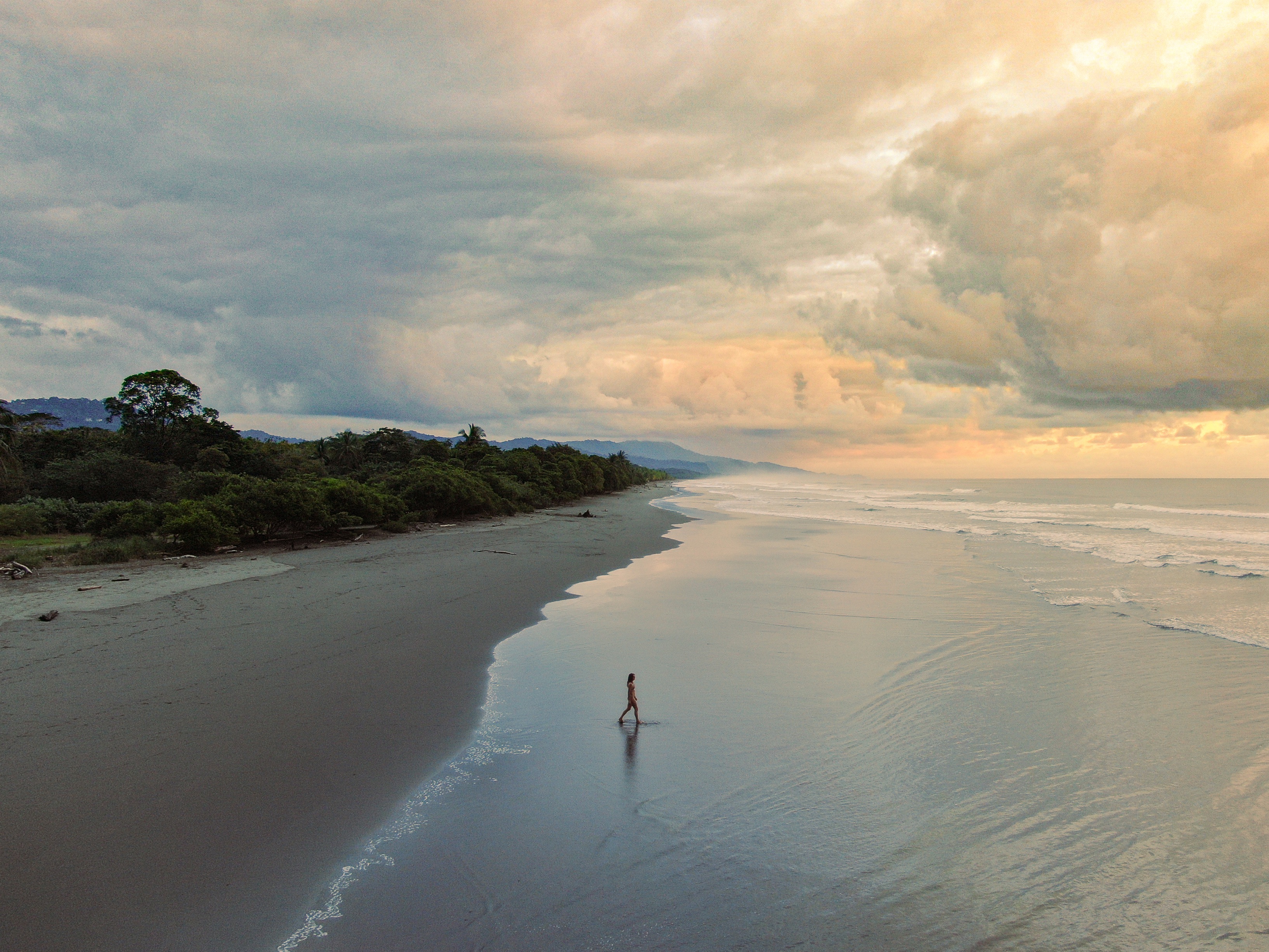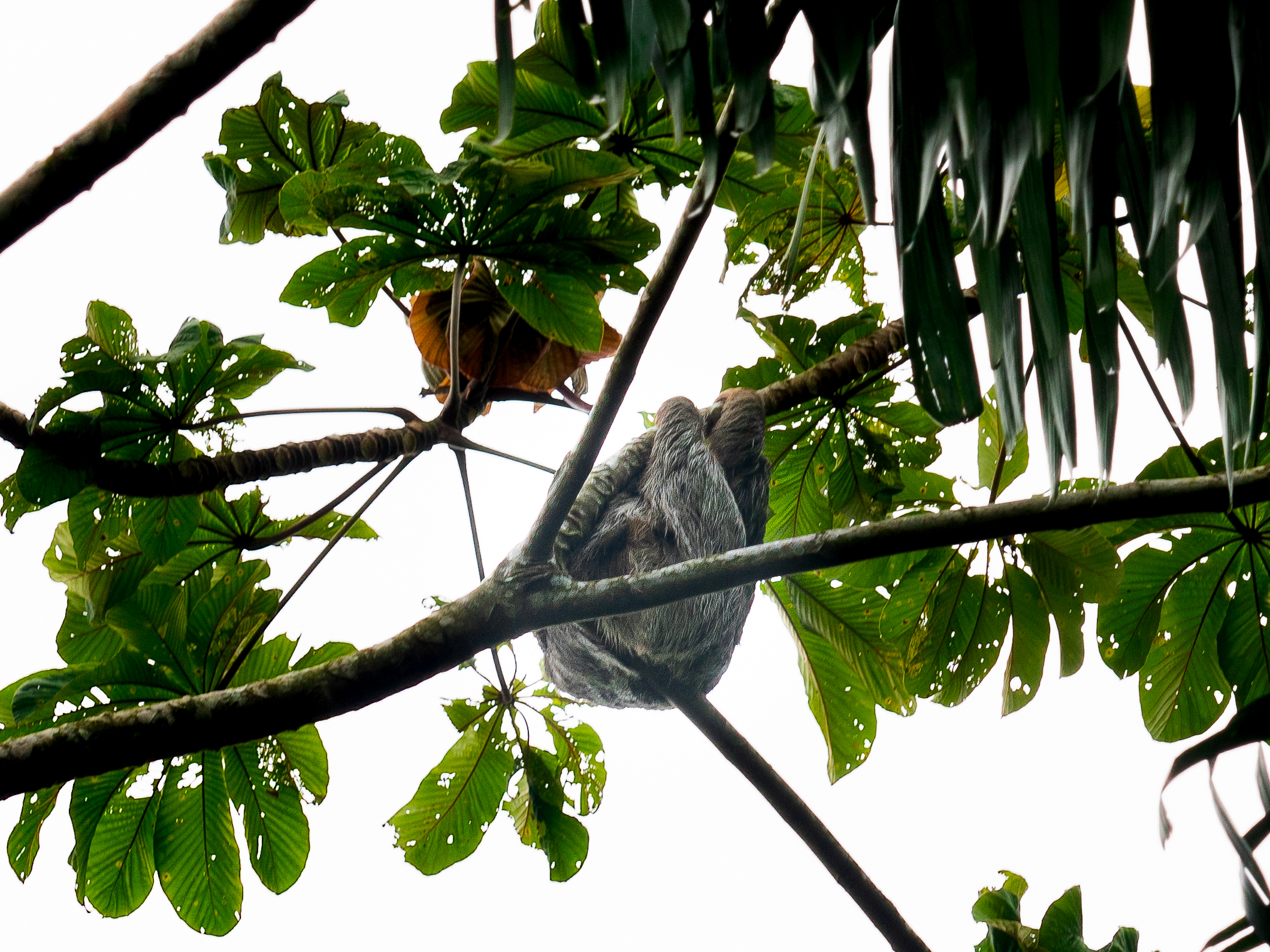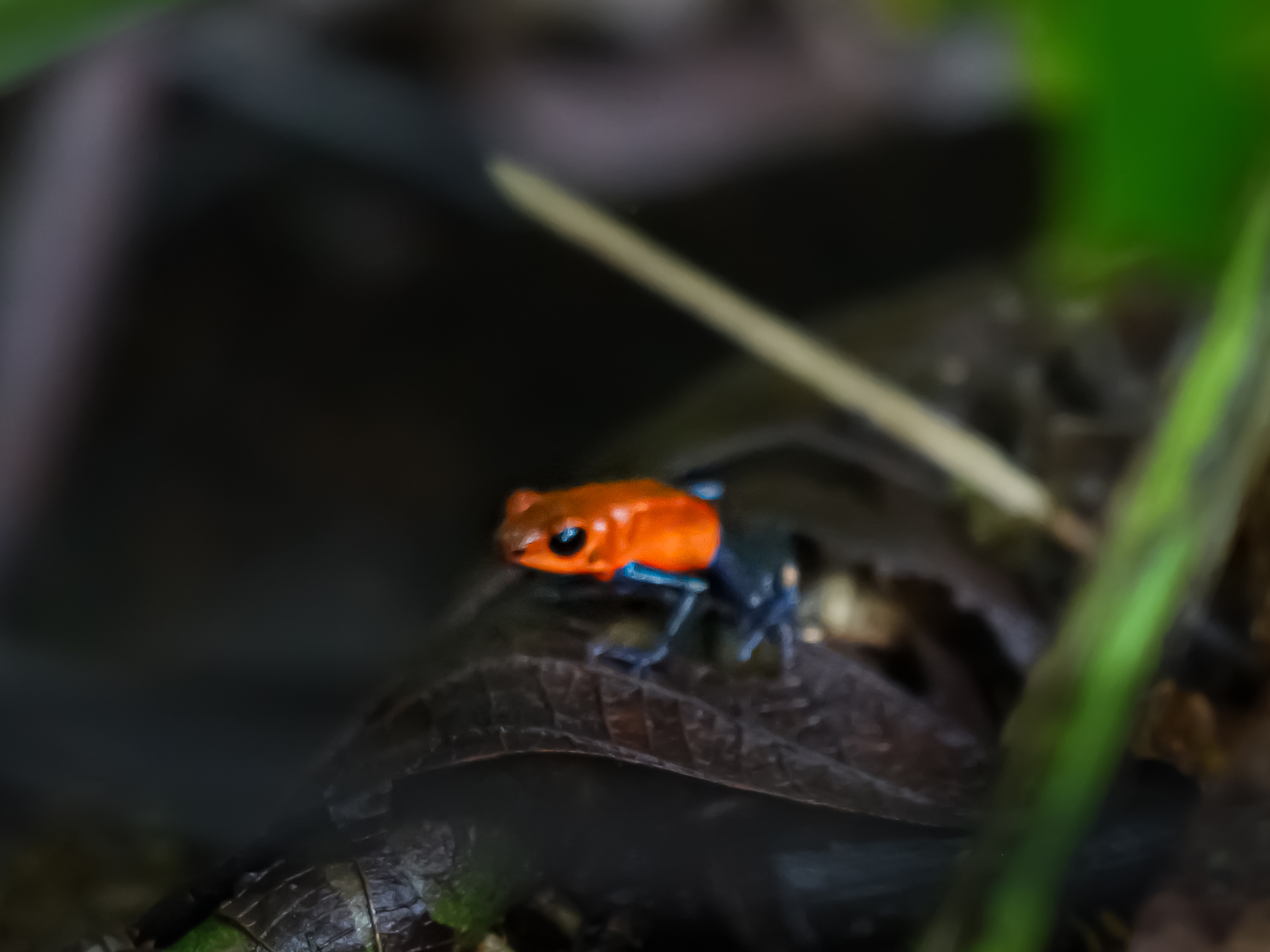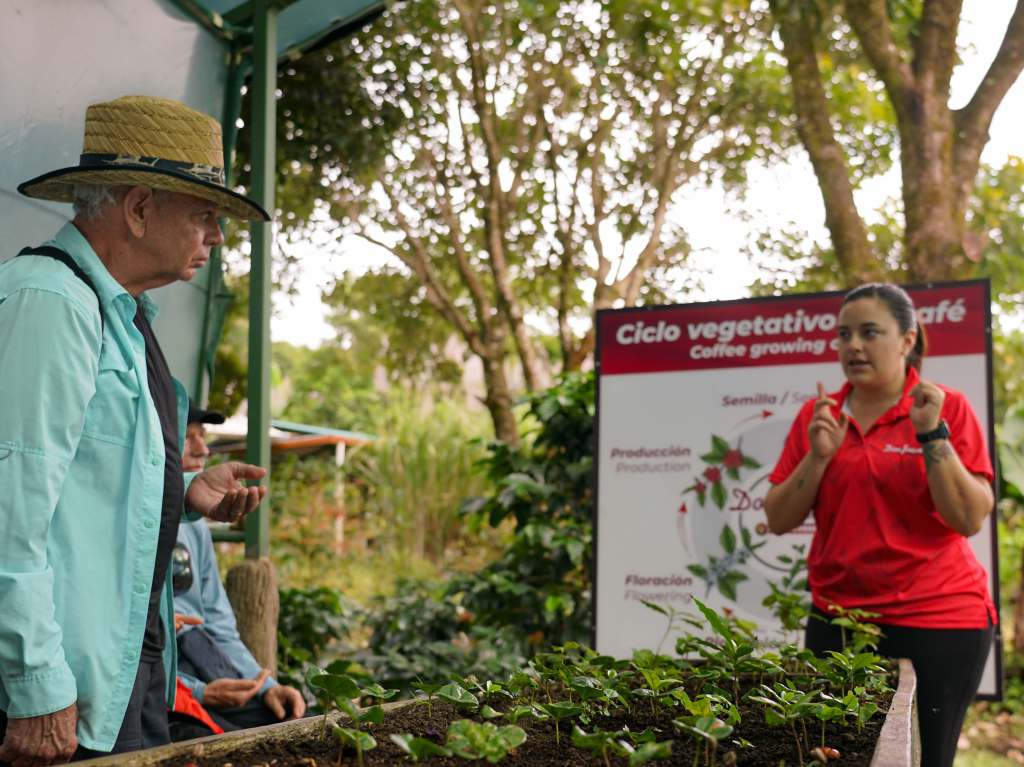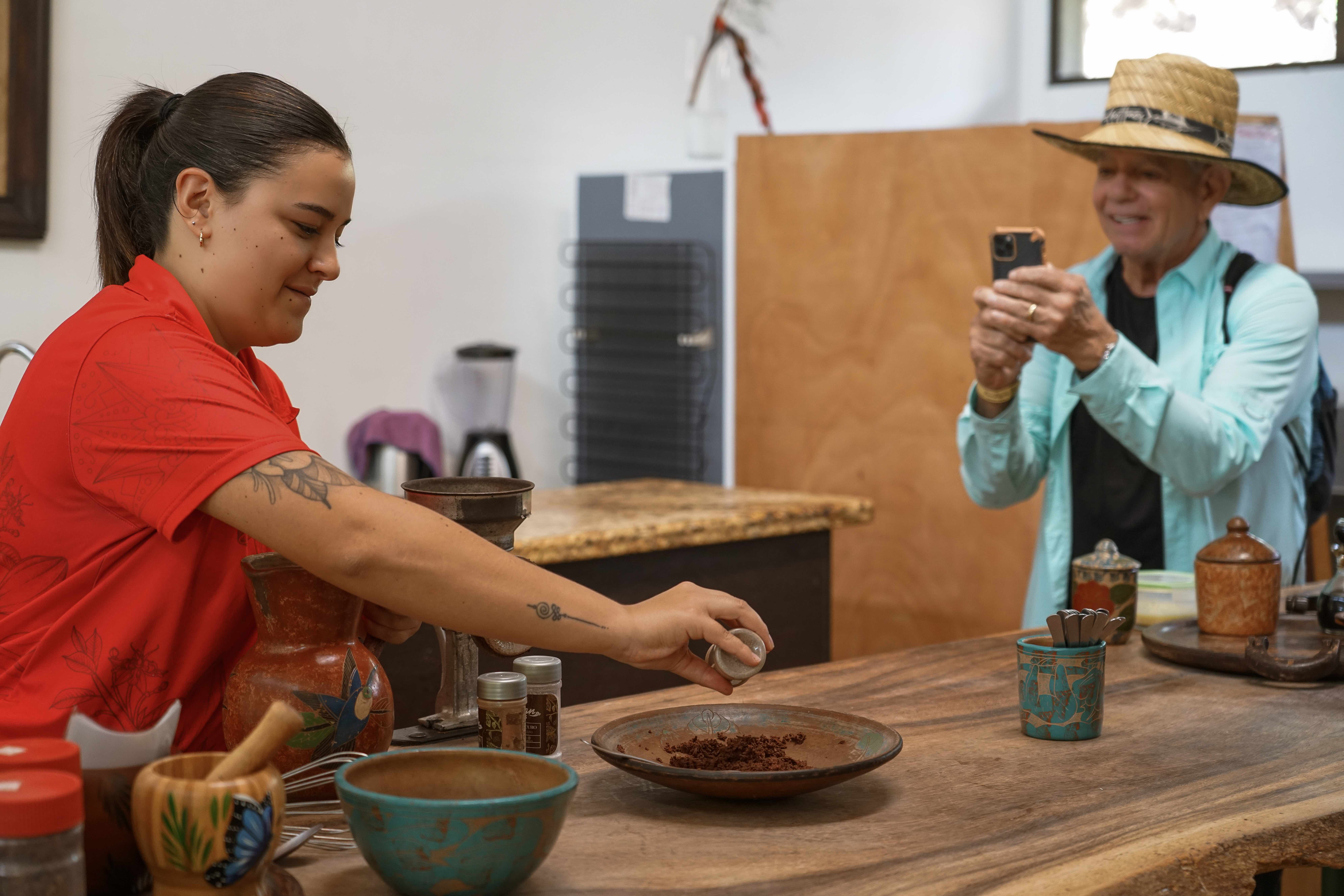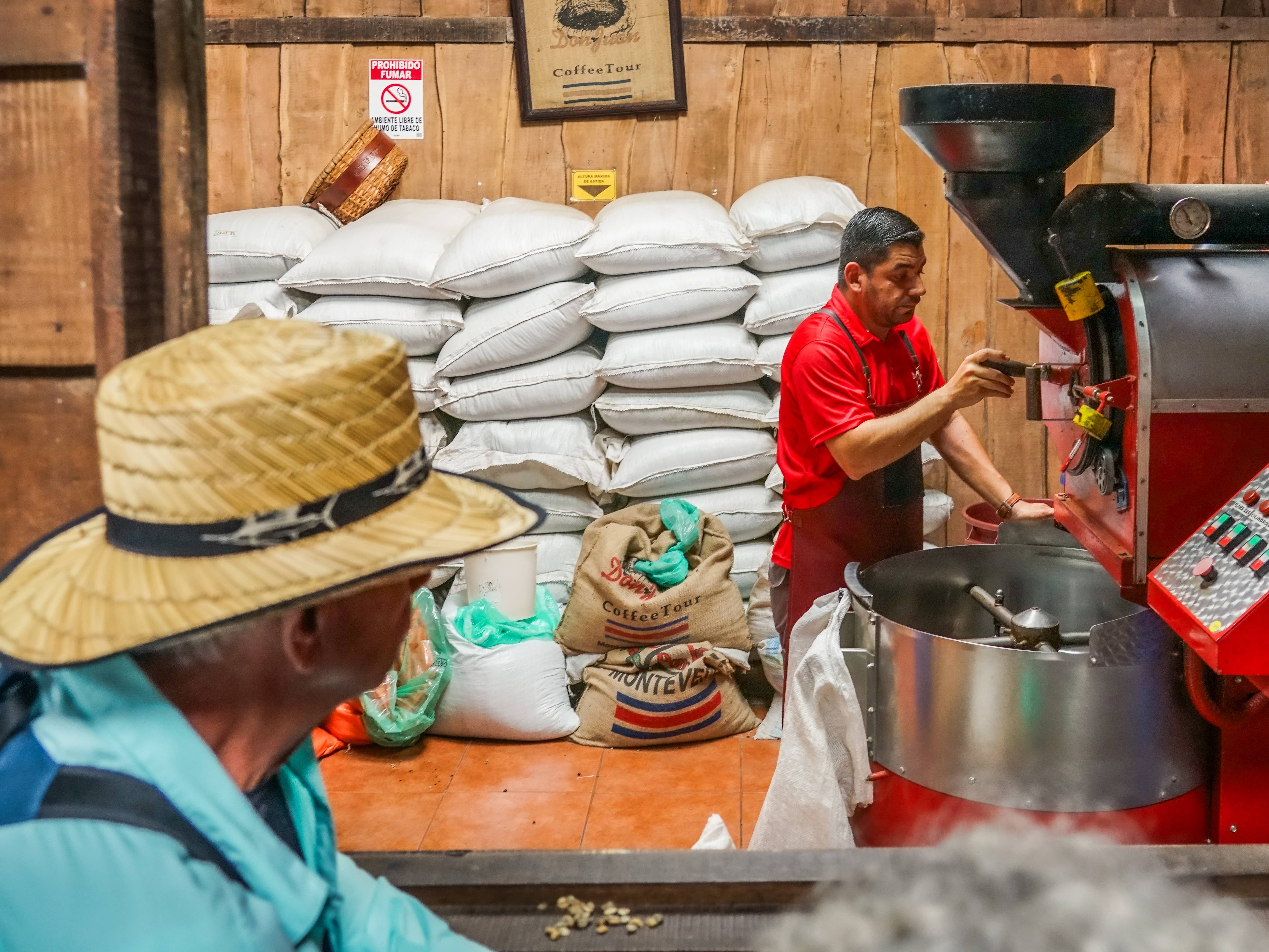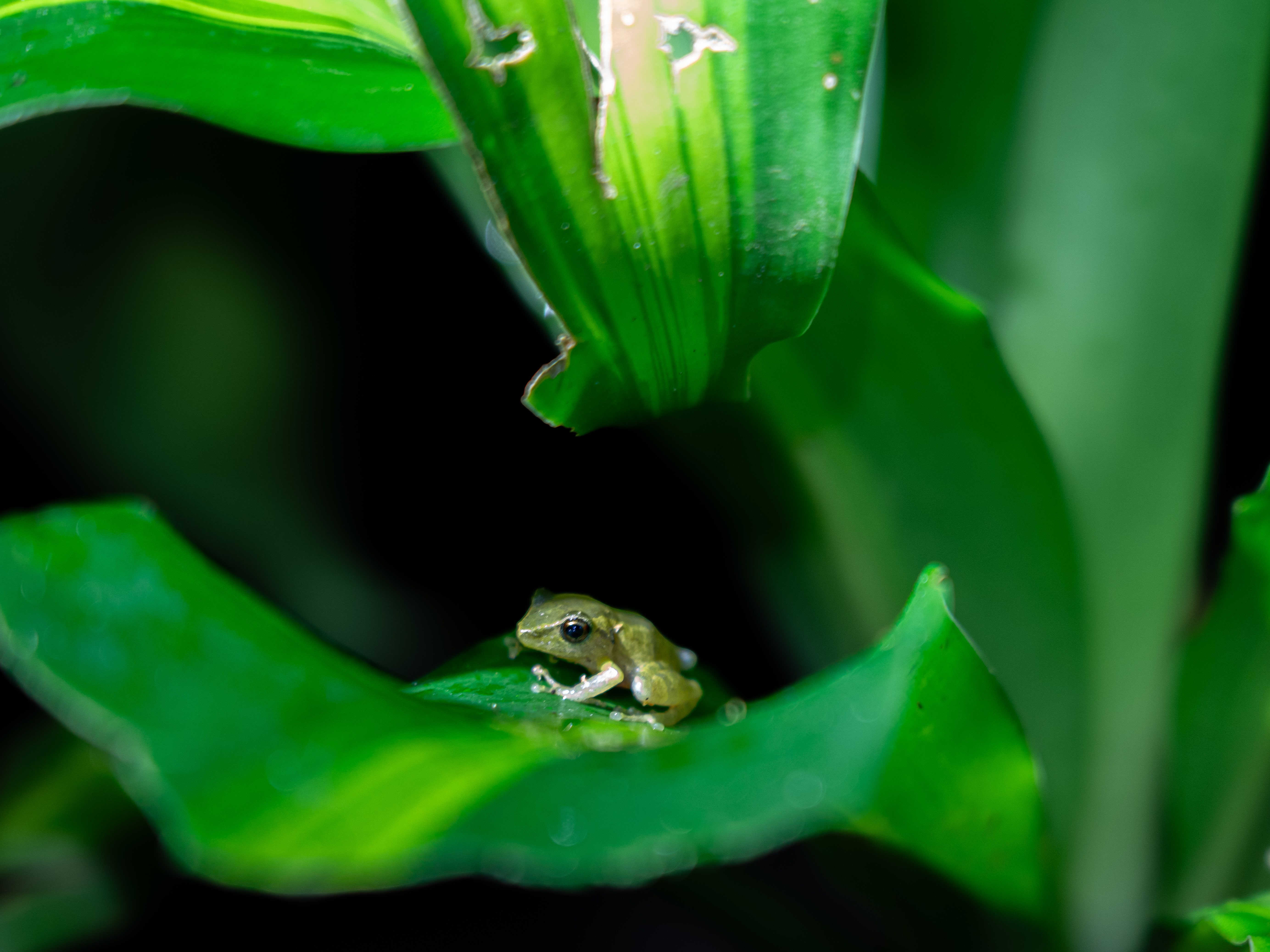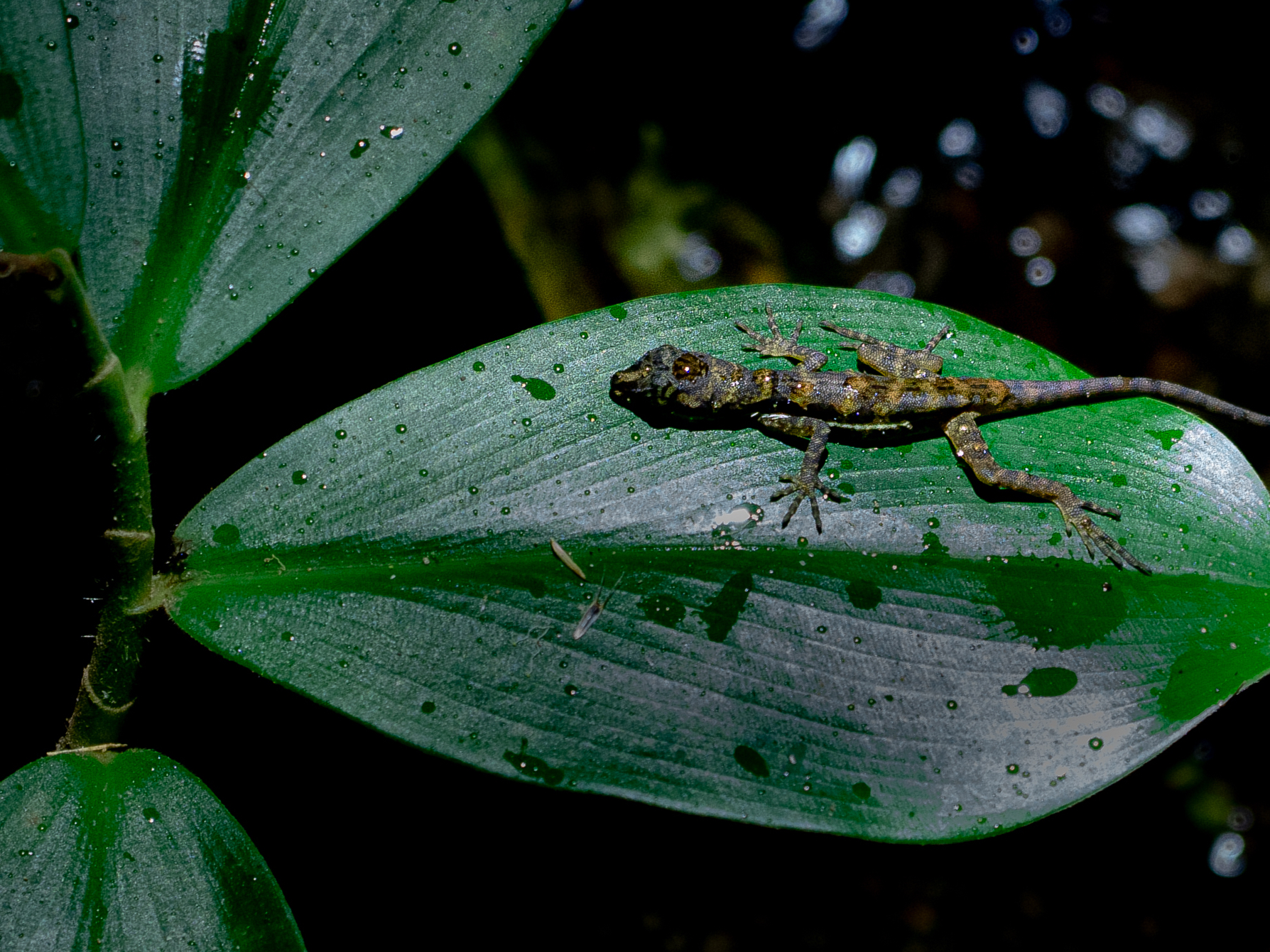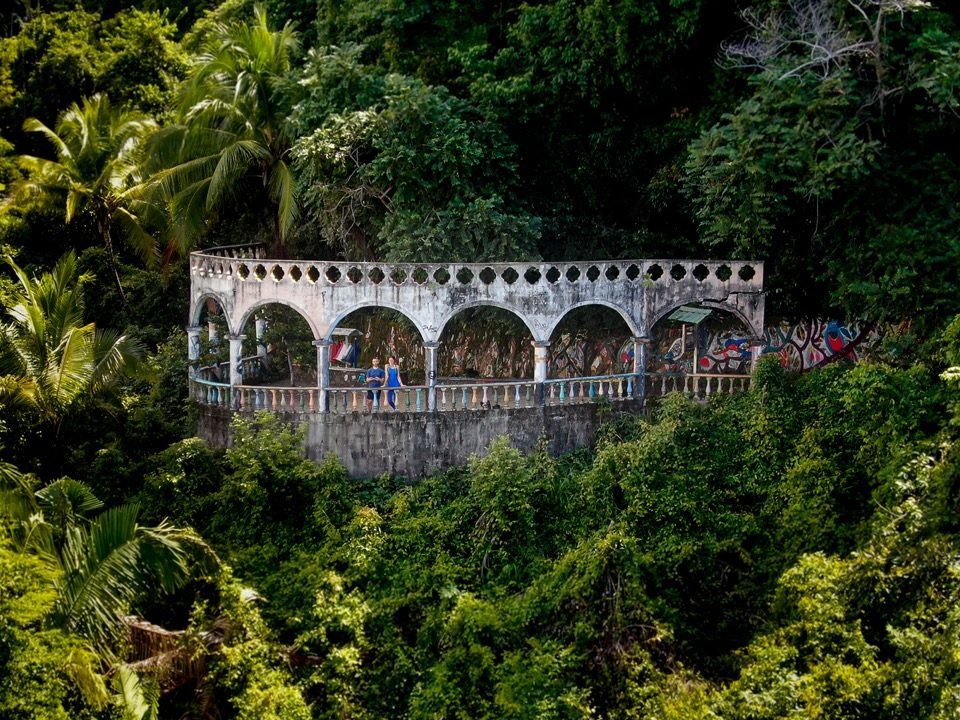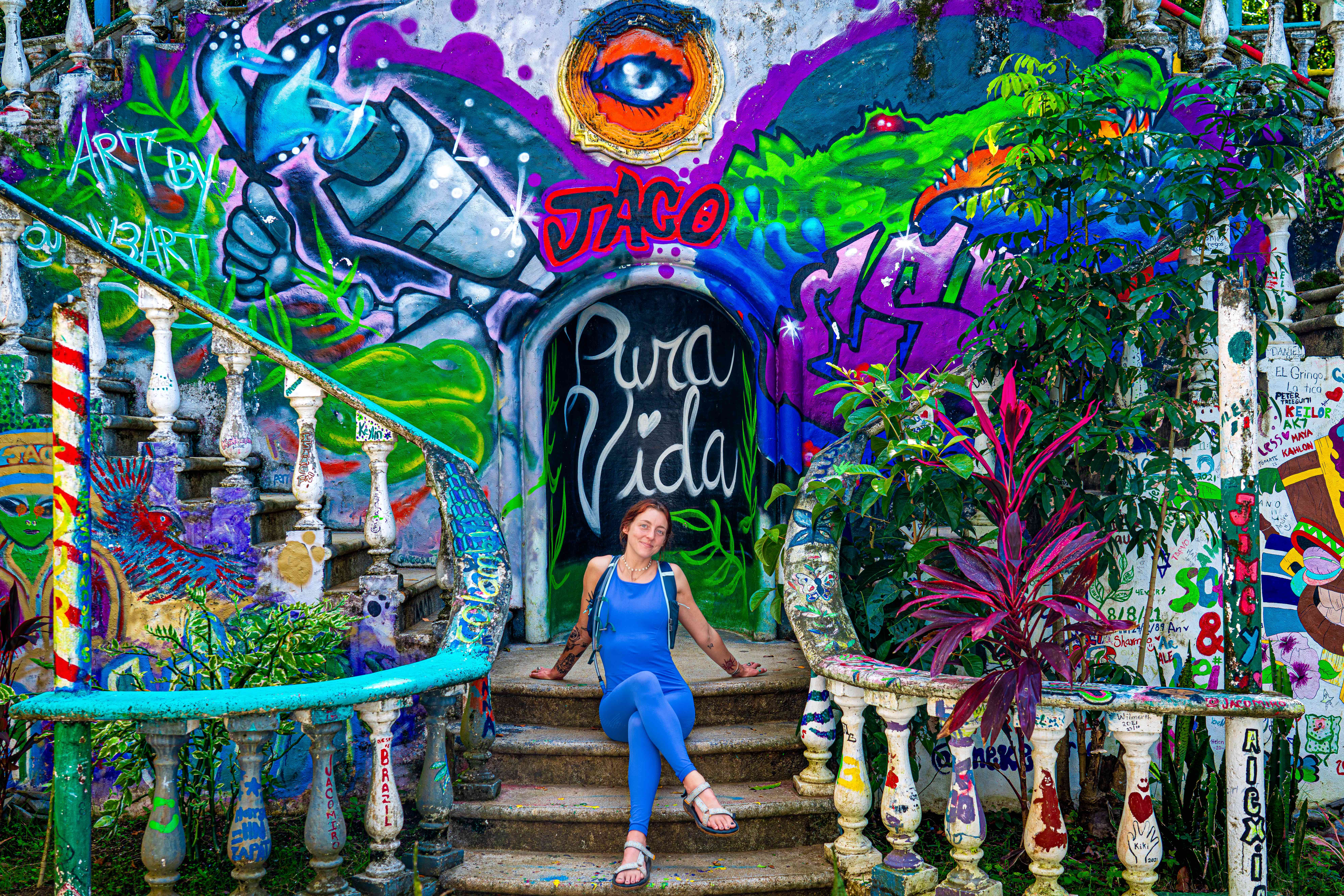the Perfect Itinerary for those looking for the best hikes in Costa Rica
Overview
It had been quite some time since my last international trip – which was actually South Africa in 2019. I was torn between a few places for a 2 week trip during late November / early December – and ended up choosing Costa Rica! Despite November being the tail end of the rainy season, I’ve always preferred braving some bad weather in exchange for lower prices and less crowds. We ended up with pretty favorable weather overall – pleasant daytime temperatures, cool night temperatures (especially in the mountainous regions), and only a few days with scattered showers in la Fortuna and Dominical.
| Cities Visited | San Jose, la Fortuna, Monteverde, Jaco Beach, Savegre de Aguirre, Rivas |
| Trip Duration | 14 nights |
| National Parks | Volcan Tenorio, Manuel Antonio, Marina Bellena, Chirripo |
| Rental Car Cost | ~$1,500 (Adobe Rental Car) |
| Accommodations | AirBnBs, Hotel Jaco |
| Late November/Early December Weather | Mountainous areas – 70’s during day, 50’s at night Beach Areas – high 80’s during day, 60’s at night Total Days with Rain: 4 |
Our itinerary started with picking up our rental car from Adobe Rental Car in San Jose, then 3 nights in la Fortuna, 1 night in Monteverde, 3 nights on Jaco Beach at the Hotel Jaco, 3 nights just off the beach north of Dominical, 3 nights in Perez Zeledon (the base of Costa Rica’s tallest peak, Cerro Chirripo), and then 1 night in San Jose before our early flights home the next morning.
San Jose
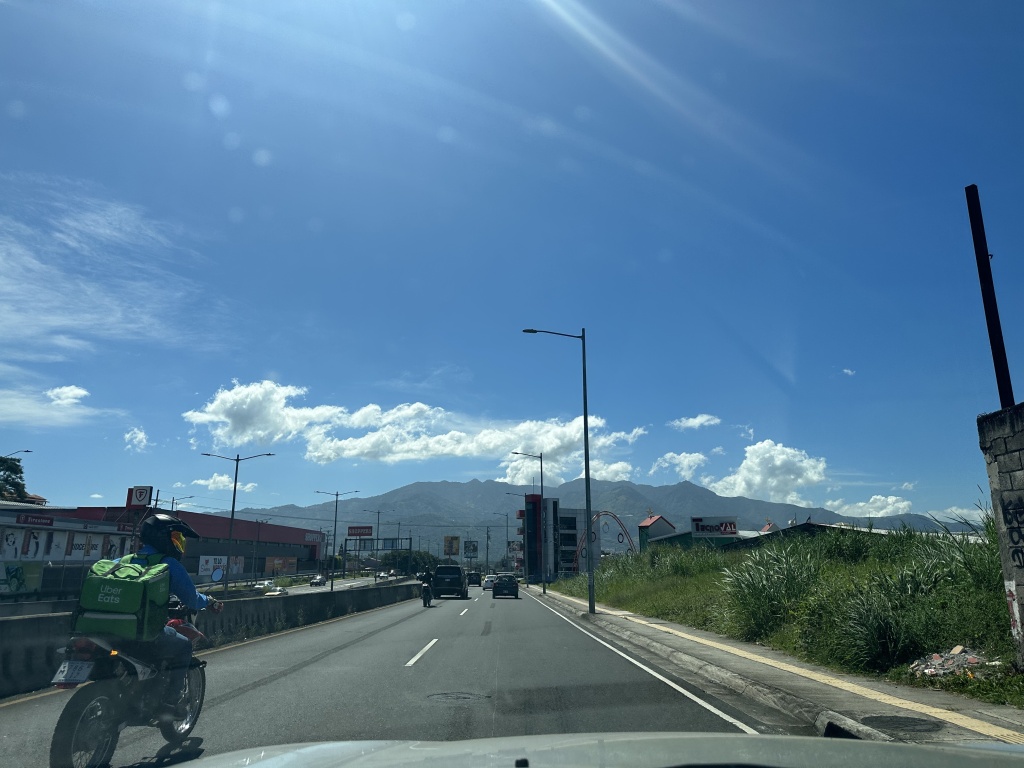
We didn’t do a whole lot in San Jose aside from grabbing our Adobe shuttle from the airport and taking the 15 minute ride to the garage to pick up our rental car. Navigating the rental car process leading up to the trip had been a bit daunting, as some of the rental quotes varied drastically, but Adobe seemed to be the most transparent and trustworthy based on reviews. Beware of some websites that will lure you in without the mandatory coverages required in Costa Rica. At the end of the day, after taxes, the mandatory coverage, and then some ‘idiot insurance’ (about $10/day for a reduction in the damage deductible and increased coverage), I paid about $1,450 for the rental car for 14 days. We went with the Automatic, compact 4×4 (not a true 4×4 but an AWD system with a button to lock the center differential) that got us a Mitsubishi ASX (comparable to the Mitsubishi Outlander Sport in the United States).
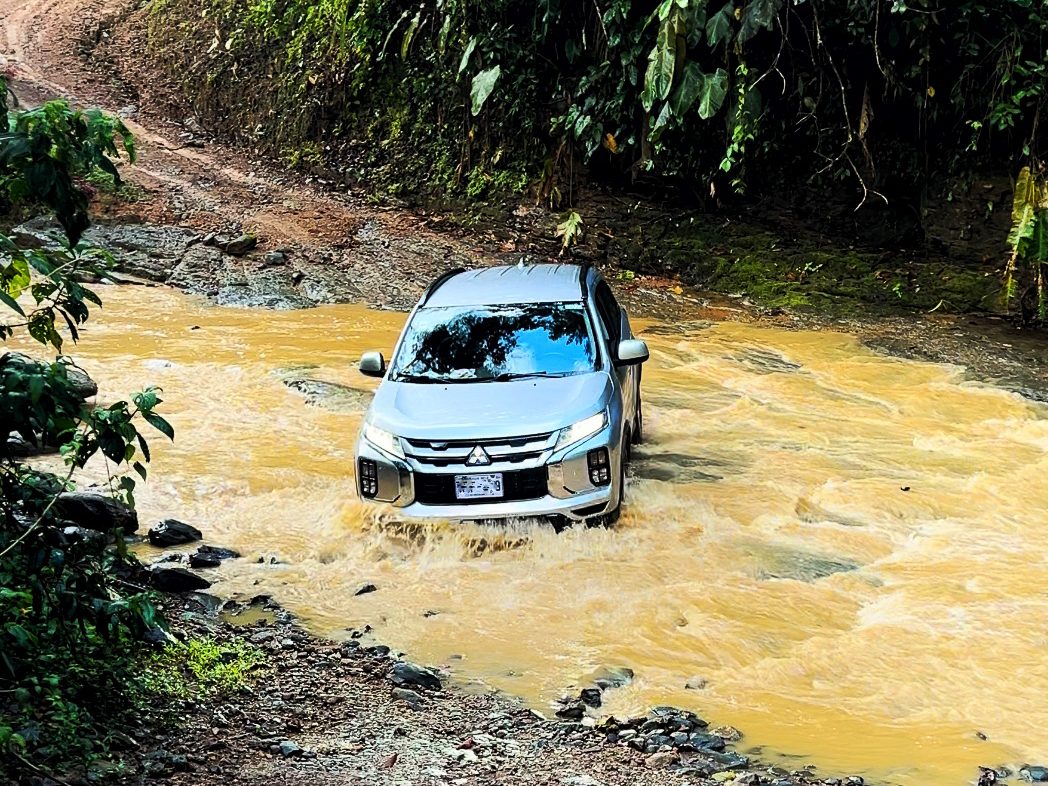
Later on, we were glad to have had the extra capability of the locking center differential when we accidentally ended up on a true 4×4 route – and had to push that little Mitsubishi to it’s limits. If you plan on venturing off of the beaten path more so than what you see in this post and the video above, you may want to consider going up to the next class of SUV or pickup truck with more ground clearance and a true 4×4 system. With that said – the only time we truly relied on our car’s abilities was on that 4×4 route. Every other road, we were more than capable of driving on and through.
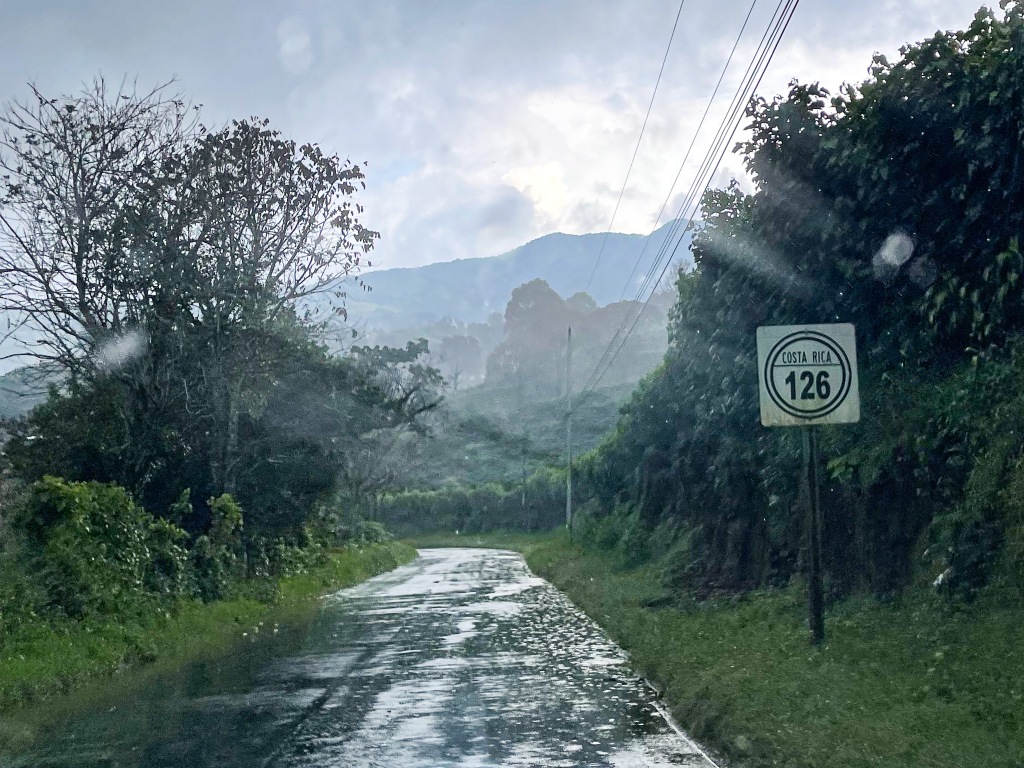
On this particular late November day, the remnants of a tropical depression were passing over our route from San Jose to Fortuna, so the ‘on-paper’ time of about 1.5 hours that our GPS gave us stretched to almost 3 hours with the rain, traffic, and then anxiety of driving after the sun went down. That first day of driving would turn out to be the worst weather of the trip.
Fortuna
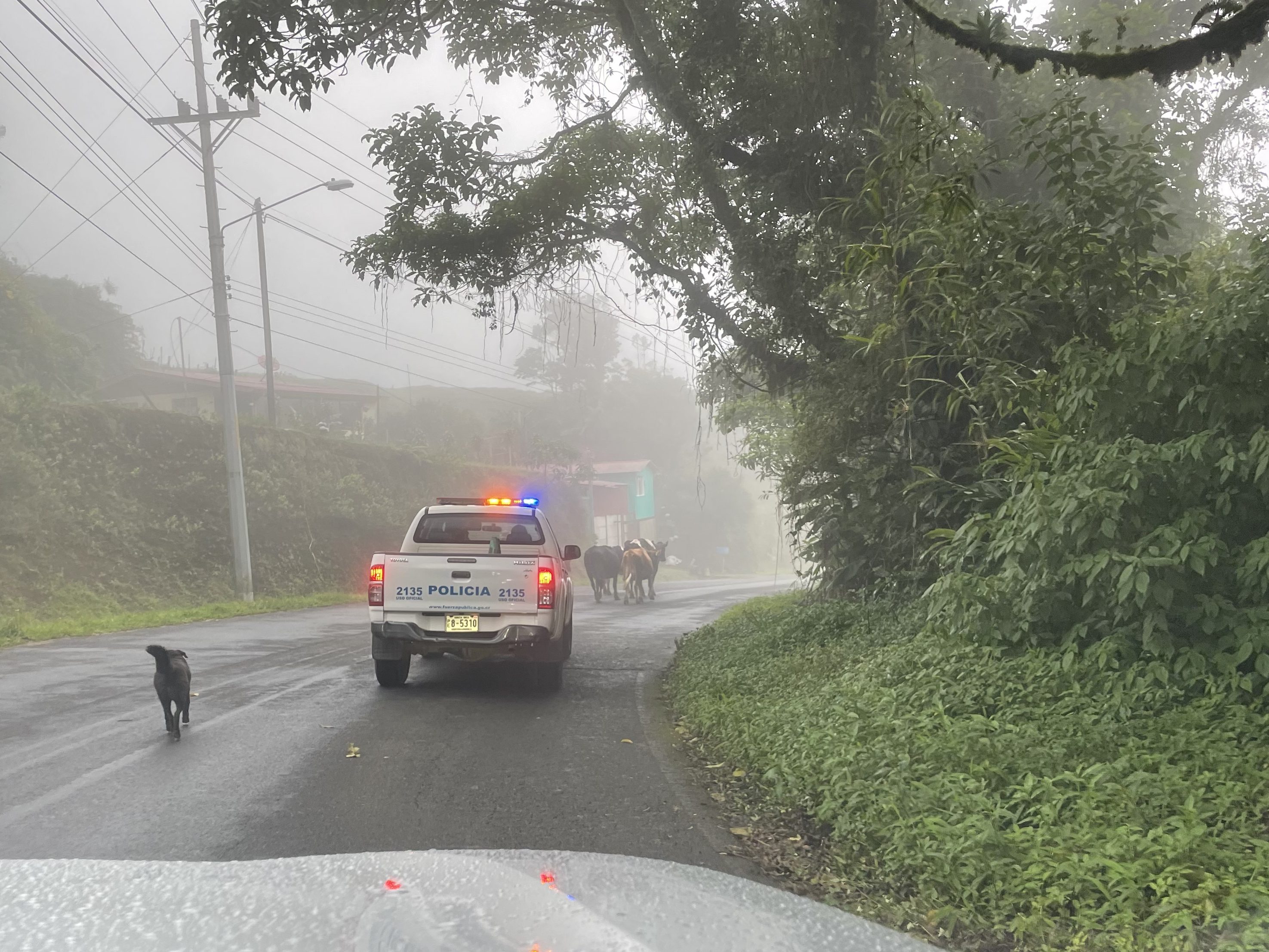
We arrived in la Fortuna a little before 9pm, and went to the office in town to get the keys for our AirBnB a short drive away. The rental office provided s wit some helpful maps and suggestions for the area, and then had us follow them to the AirBnB. Always exercise caution in situations like this, especially if you are traveling solo. The professionalism of the office staff and information about our Airbnb bookings made us feel secure enough to follow the employee to the AirBnB. Once there, we were introduced to the host/homeowner, Lorenzo, who showed us how to work the hot tub and where to leave fruit for the native birds in the morning. He’d end up stopping by each morning with bananas to leave for the birds, and I enjoyed getting to chat with him with my basic Spanish skills.
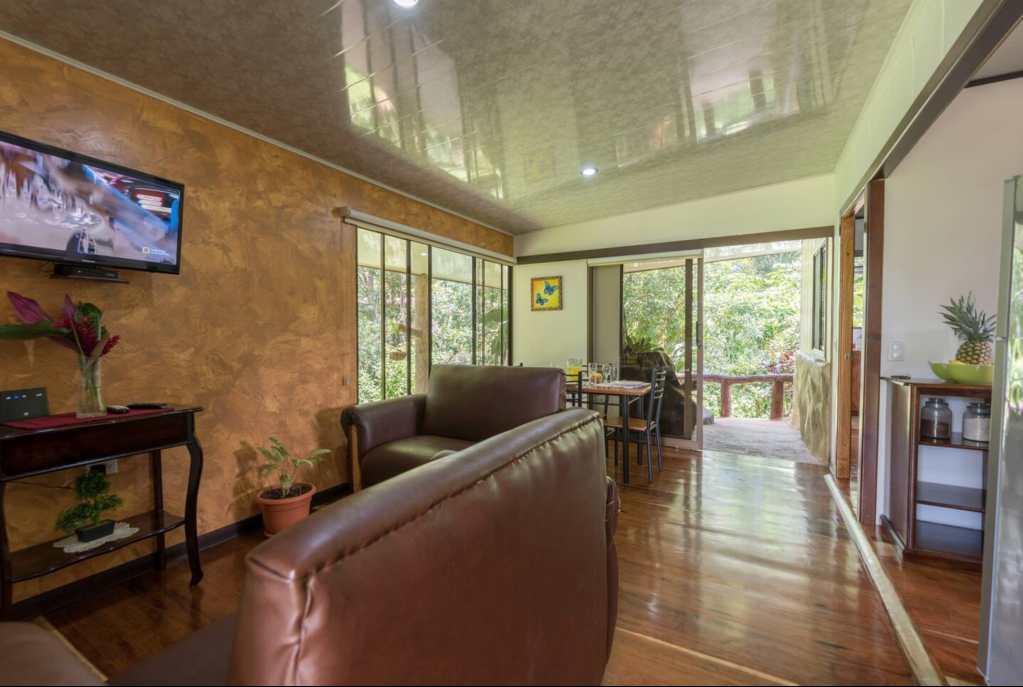
The spot had began its life as a 40 foot storage container, with a central living room area added on in the middle, making it into a kind of short “T” shape. Each room had its own mini-split AC system (which we were grateful for) as well as its own bathroom. The hot tub and porch out back were a great way to unwind at the end of a day of hiking, particularly during la Fortuna’s frequent (but brief) afternoon showers. On the first night, we set our stuff down and then made a quick trip to the supermarket, stopped in town for a bite to eat, and then called it a night.
Day 2
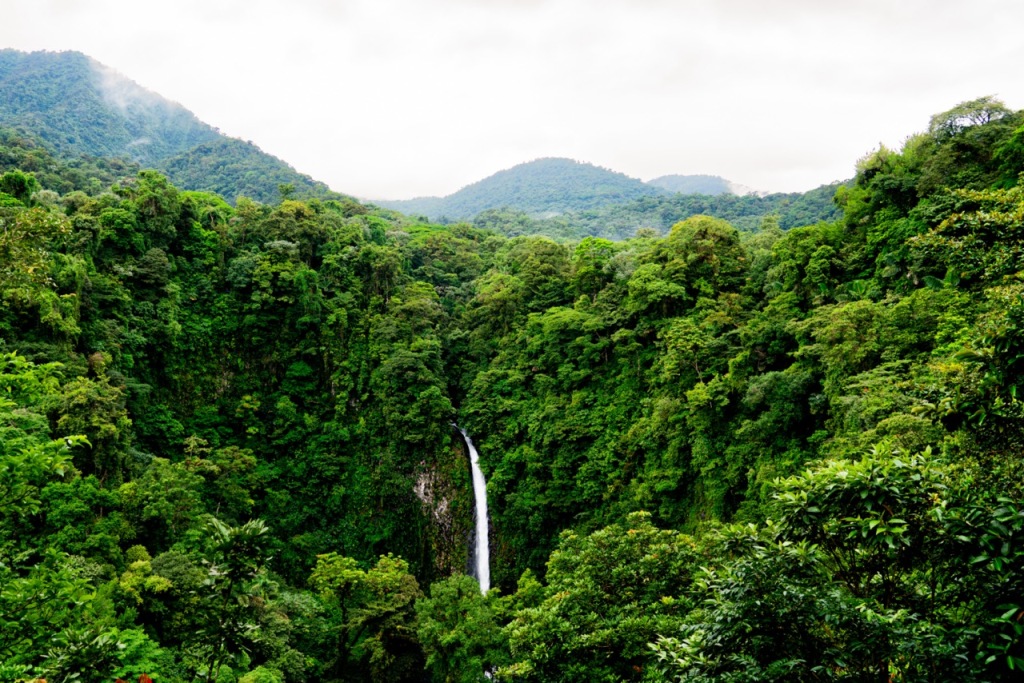
The next morning, we got an early start to set out for la Fortuna Waterfall. We were one of the first cars (and people) down to the falls after paying the $18 USD per person entry to the park. Most of the trails/waterfalls/parks in Costa Rica would have some sort of entry/permit/reservation fee throughout the trip, but luckily they were all pretty affordable. Though, that can add up if travelling with a family, so be sure to add up the cost of trails you’re considering for your vacation there. It was a short and quick hike down to the waterfall, consisting of a few hundred paved and metal steps. There’s an overlook from above as well that we stopped at before heading all of the way down, where we happened to see a howler monkey in the trees. This would be our first little taste of wildlife on the trip – but certainly not our last.
At the bottom of the falls, you can wade in for a swim, or go back down the creek a bit for some calmer waters. More and more people started to crowd in a short while after we arrived, and on our way back up we passed a lot more people. Get there early if you can for the best mix of lighting and lack of crowds.
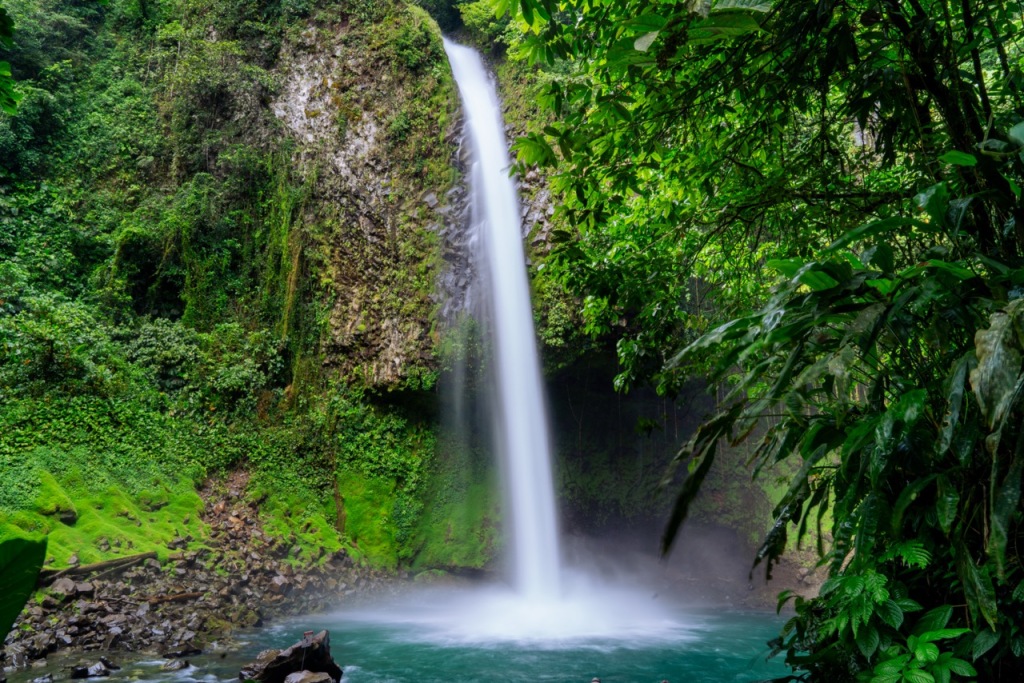
The next stop on the trip was about a 30 minute drive (past quite a few hot springs resorts that we didn’t end up having time for) to the Mistico Arenal Hanging Bridges. These bridges are suspended anywhere from 30-100 or so feet above the ground in the canopy of the rain forest. These bridges give a unique perspective into the forest as opposed to the typical view of looking up. We passed other guests that had gone with the guided tour option – which is nearly always the best way to see wildlife in Costa Rica. We often walked right on by things until we stopped to see a guide pointing out the various creatures of the forest, including various insects, birds, sloths, tarantulas and more. Entry tickets were $26 USD, and we also had a pretty good and moderately priced lunch at the Restaurante La Roca Bistró at the entrance of the park overlooking the Arenal Volcano.
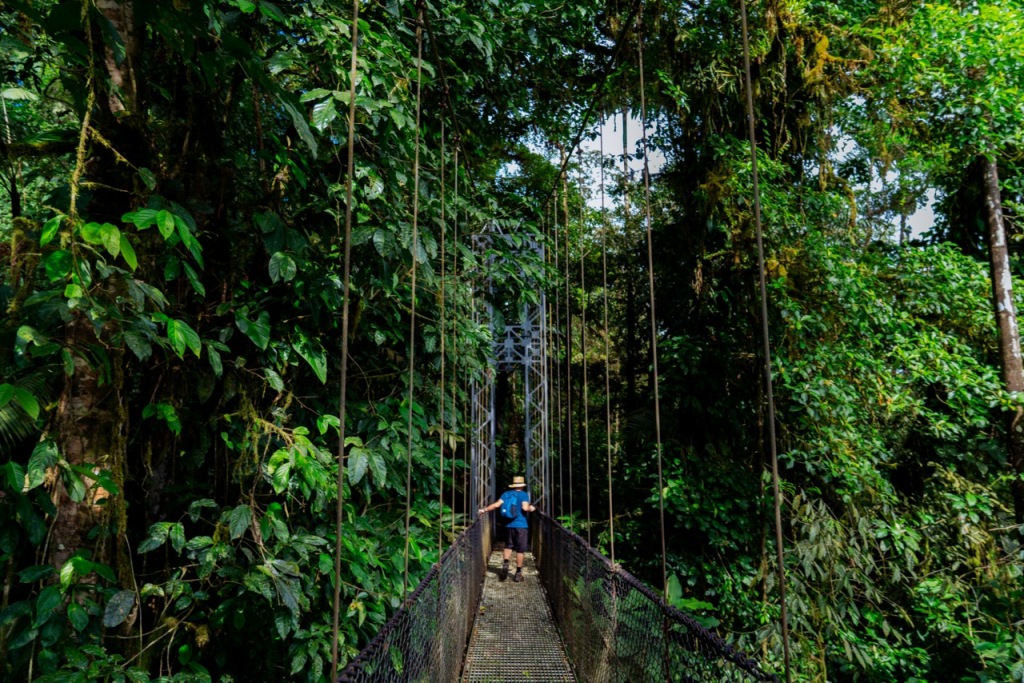
The next stop led us to the Arenal Volcano National Park – the park that encompasses the 5,400+ foot tall stratovolcano that can be seen from around Fortuna. The volcano has been dormant since 2010, with its last major eruption occurring in 1968. Luckily, the volcano didn’t wake back up during our short visit, the clouds around it did break just long enough for us to be able to see the entire cone looming above us.
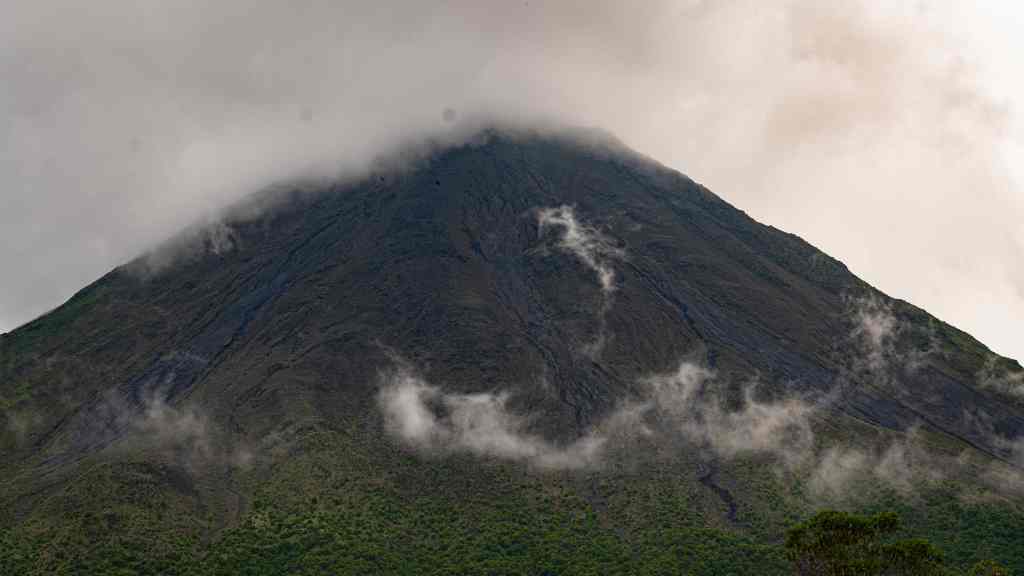
We took the trail from the main parking lot to the ‘mirador’ (viewpoint), which could be as long as 3.5 miles, but we shaved off a bit to keep it around 2.5 miles. There were some larger and loose rocks on parts of the trail that can be tricky if you’re not used to hiking rocky terrain, but overall it was an easygoing trail suitable for most. If you’re looking for an absolutely crazy and challenging route while you’re in Costa Rica, scroll down to the end where we tackle the 26.5 mile Cerro Chirripo Trail.
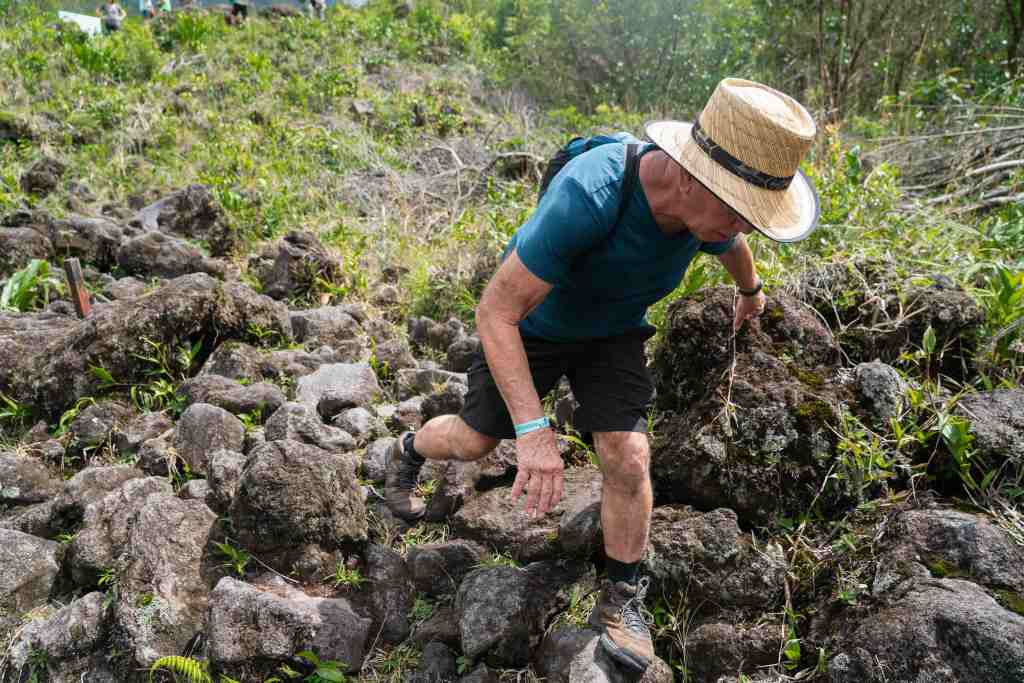
Day 3
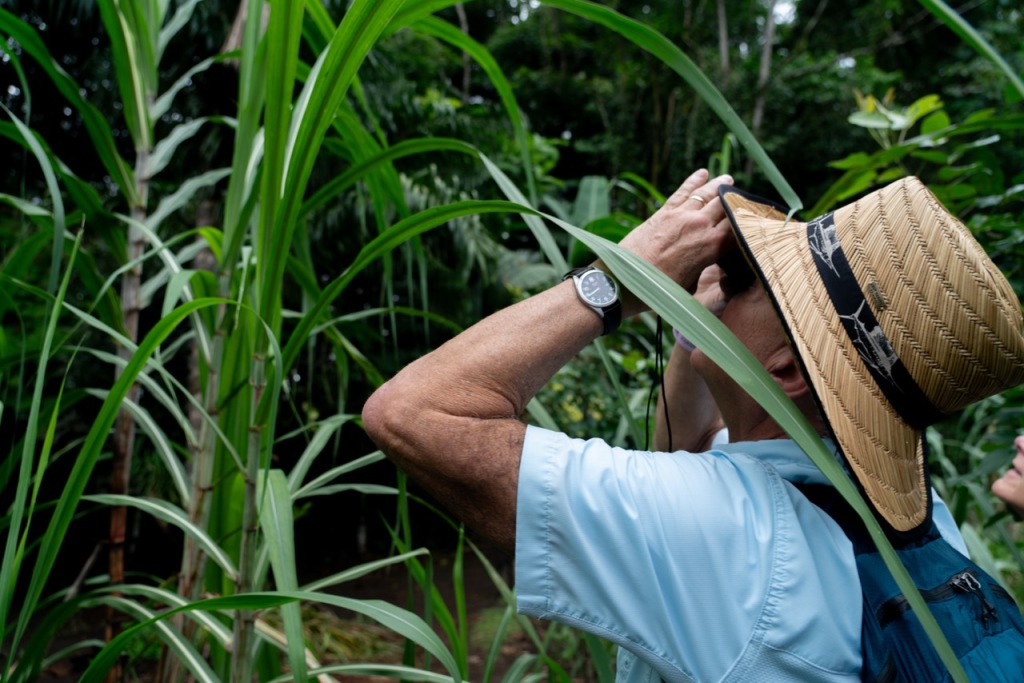
We started off the next day with a quick stop by the local Bogarin Trail, a small private reserve which claims to be home to over 30 individual sloths, amongst other fauna such as poison dart frogs, toucans, coatis, and more. We opted for the self guided tour again (about $12 per person), and by the end of the 2 ish miles of walking, our necks were sore from looking up into the canopy.
We did happen to see two sloths (which are VERY hard to find on your own), a few poison dart frogs, hummingbirds, and what we were almost certain was a toucan flying by. Overall it was a nice and relaxing walk, though you really have to work to be able to find the wildlife. If you have your heart (or camera lens) set on finding sloths during your trip, definitely consider hiring a guide for at least one of your excursions.
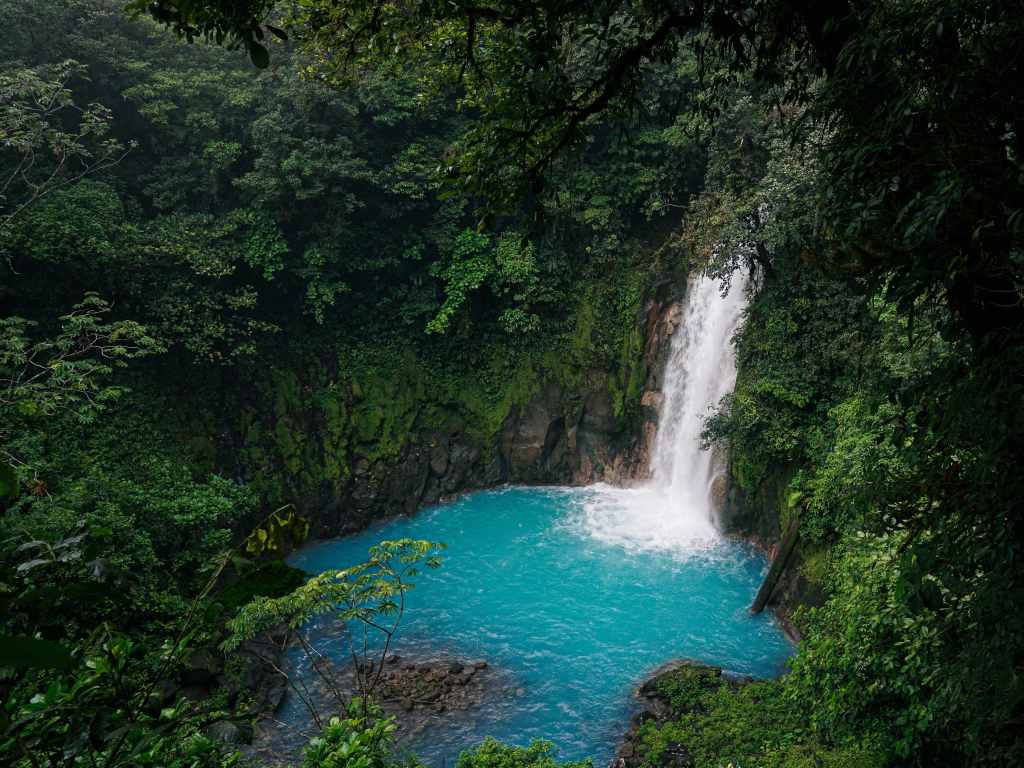
After a quick bite to eat in town, I couldn’t resist paying a visit to the turquoise blue waters of the Rio Celeste in Volcan Tenorio National Park, which had me thinking about my visit to Havasupai Falls in Arizona earlier in the year. That Gatorade blue water is a photographer’s dream, and truly a sight to see (especially for my dad, who had never seen water that color before). It was an about a 1.5 hour drive from Fortuna through the countryside. Keep in mind that you will need to reserve your ticket online through the Costa Rica Environmental Conservation’s website after registering and creating an account. You will also need to use this system for other national parks in Costa Rica (such as Manuel Antonio or Chirripo), so I would recommend getting your account created before your trip.
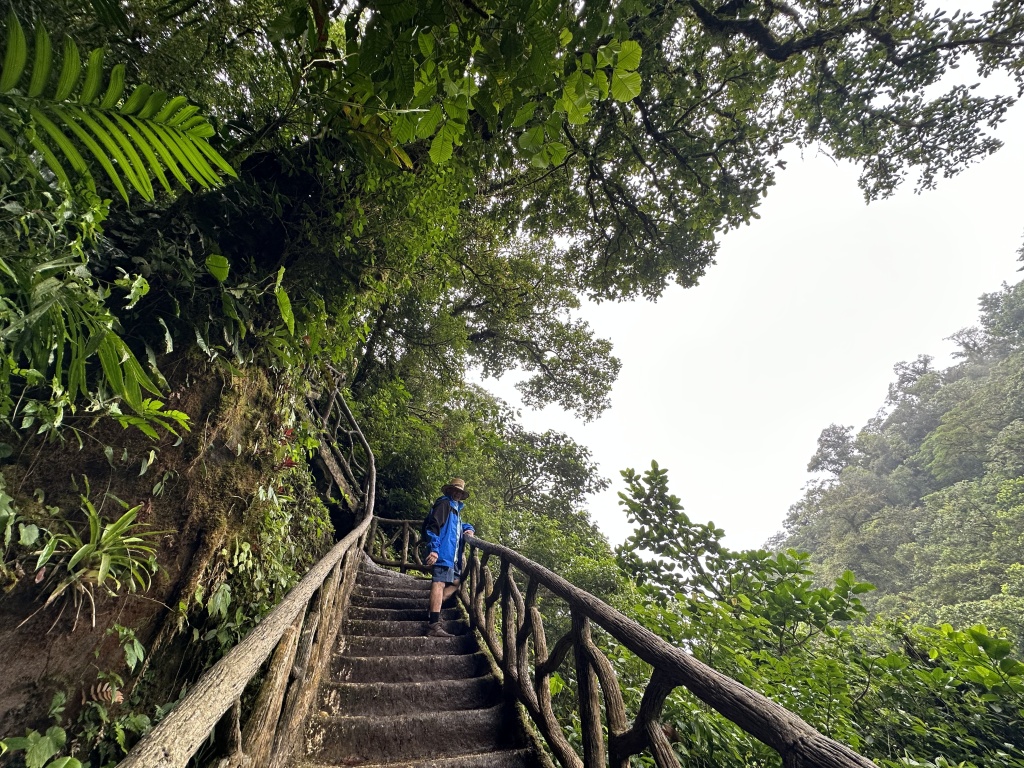
To my recollection, it was around $10 per person for the park entry, and then another $2 or so to the parking attendant. The trail to the falls was around 3 miles round trip (you could continue on past the trail above the falls, but the 600 ish feet of elevation gain to the falls was enough for my 67 year old dad). Along the trail we did see footprints from a tapir (an animal that looks like a cross between a small elephant and an anteater), but didn’t get to see the tapir itself.
From there, we headed back to our AirBnB in Fortuna for some R&R in the hot tub before our departure the next morning. While we kept busy during our time in Fortuna, some other activities we didn’t get to were the Hot Springs Resorts, zip-lining, or the el Salto rope swing. But, we were quite satisfied with what we packed into two days there.
AirBnB – Arenal Luxury Paradise (2 bed, 2 bathroom, hot tub) Total Cost for 3 nights: $450
Monteverde
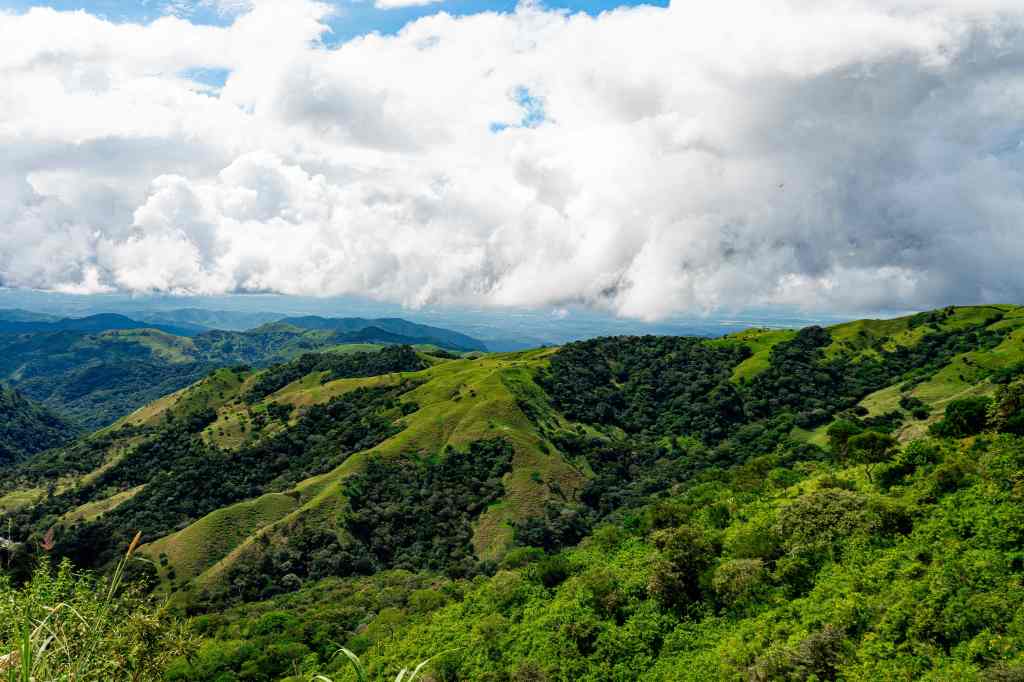
Day 4
While the drive from Fortuna to Monteverde is only around 70 miles, it will take 3-4 hours depending on the road conditions and traffic going through the mountain roads. The roads were often bumpy, twisted and narrow, and so you were never really able to get up to a significant speed. As you work your way away from the rain forests of Fortuna towards the cloud forests of Monteverde, you’ll find yourself driving through the clouds at times and beneath slopes of coffee trees at other times. We got checked into the Cloud Forest Cabin AirBnB ($73 total for one night), which was a beautiful little apartment with mountain views, a gated parking lot, and quick access to downtown Monteverde.
The airbnb was just a stone’s throw over to the Don Juan Chocolate and Coffee farm, which conducts educational tours through the farm and a breakdown of the processes to create chocolate and coffee. Coffee is a huge export for Costa Rica, and it was incredibly interesting to see the in depth process behind making a cup of coffee (or chocolate bar). The tour took about two hours, and Don Juan offers a guided night walk as well (which we opted for, bringing our total for the the two tours to around $40 per person).
We went to grab some food and a few beers at the Monteverde Brewing Company before the night tour, where we would see lizards, poison dart frogs, glass frogs, sloths, spiders and a variety of birds nesting in the trees. It was crazy to see how the guide was able to pick out animals that were seemingly so hidden from the average person’s view. We ended up stopping back into the brewery again after the night walk, since it was technically Thanksgiving back in the states, and having another local brew felt like the right way to celebrate.
Day 5
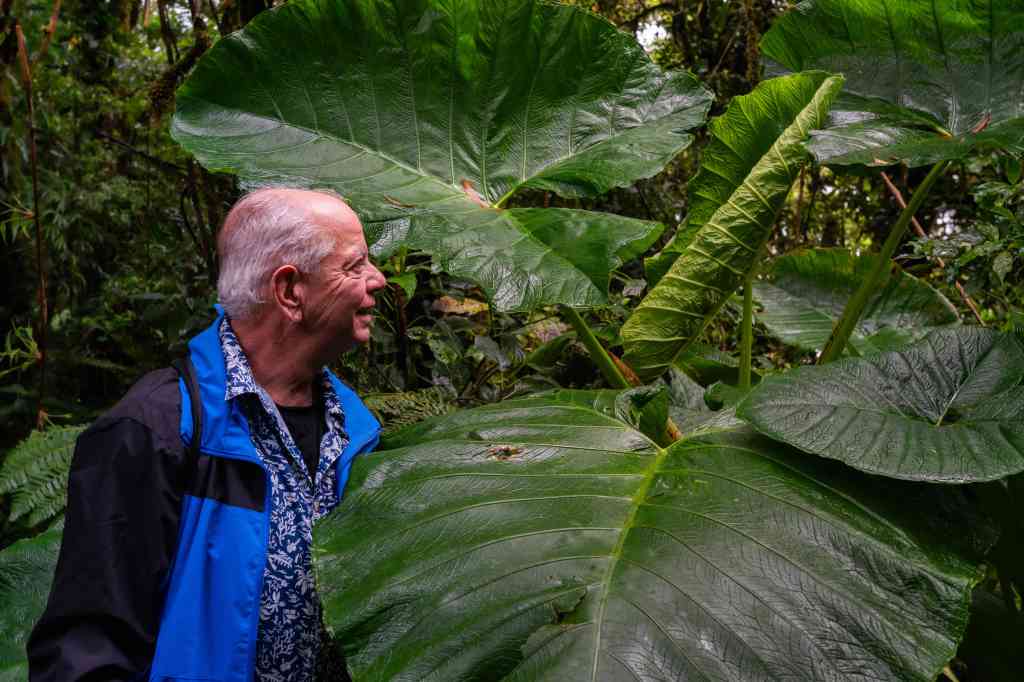
The next morning we set out for the Santa Elena Cloud Forest Reserve , as it was said to be a little quieter and less tame than the Monteverde Cloud Forest Reserve. While we didn’t go to both, we found that the Santa Elena reserve was pleasantly quiet with just a few other groups out, and a moderate entry fee of $18 per person. It’s a mystical experience walking through these forests as the clouds wash over you and wrap around you at times, which definitely added an element to it all.
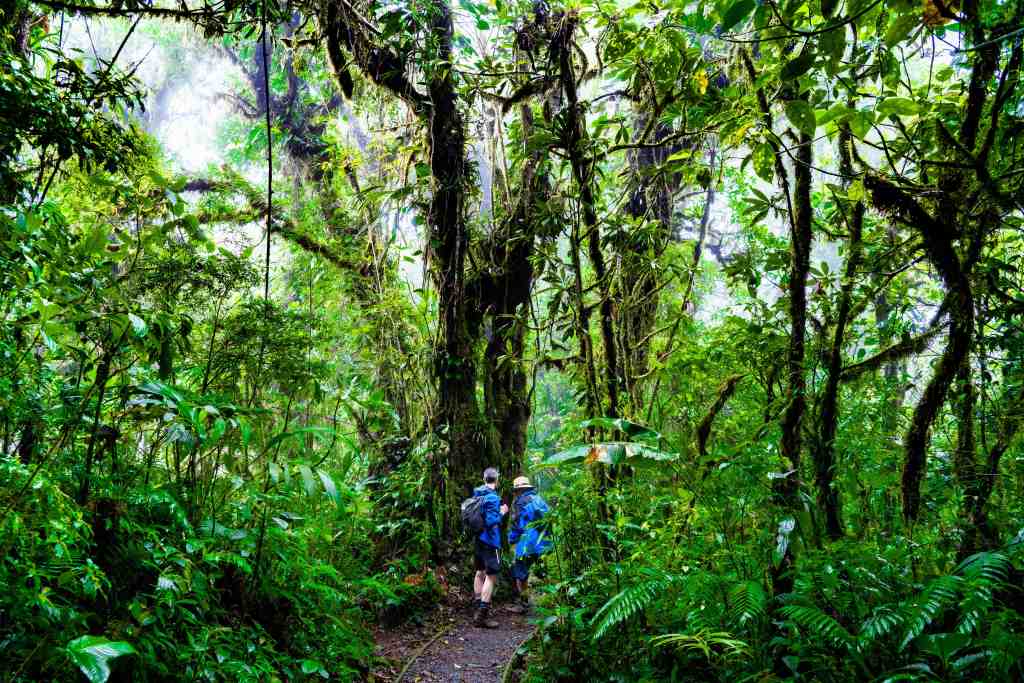
We wandered through for a few miles, taking in the greens of some of the most dense vegetation I’d ever seen (as well as some of the largest leaves too). There was an obversvation deck around the middle of the trail, but due to the nature of it being a cloud forest, your better views were had from down below. The only critter we had spotted was a large centipede – so definitely consider the guided tour option if you’re more interested in the fauna than the flora.
From Santa Elena/Monteverde, we set out for a few days of beach time. The drive to Jaco beach wasn’t as rough as the drive to Monteverde, since most of the roads were paved and the closest thing Costa Rica had to ‘highways’. It was quite the shift heading out of the cloud forests and down to the much warmer pacific coast.
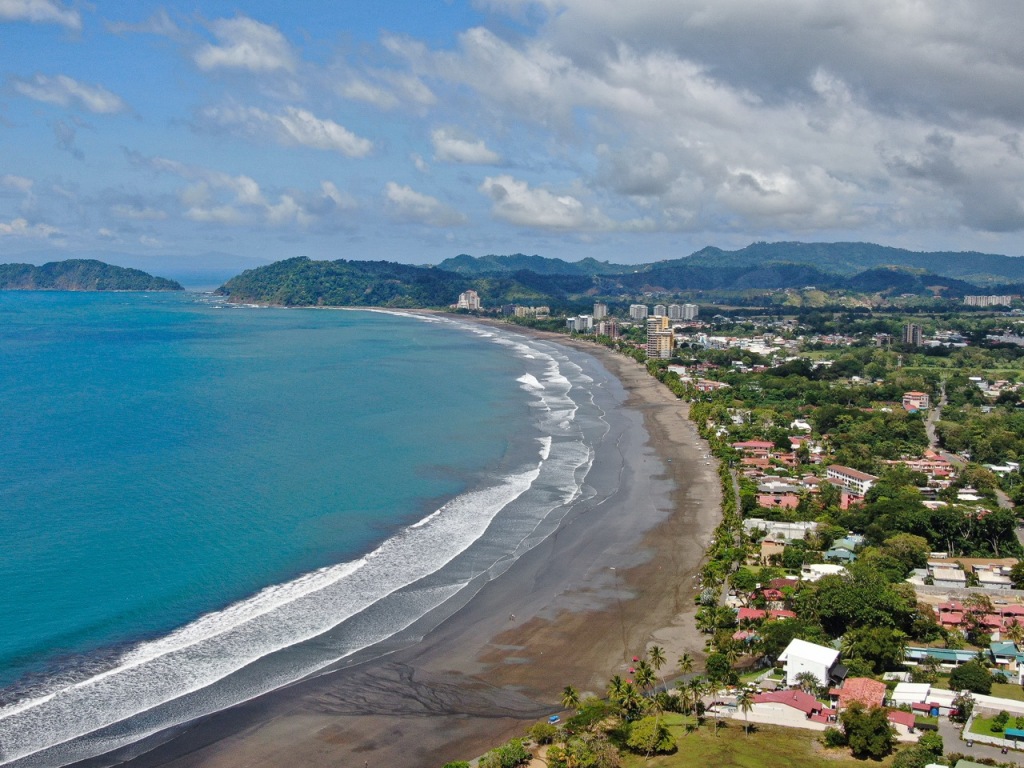
Jaco Beach
Day 5
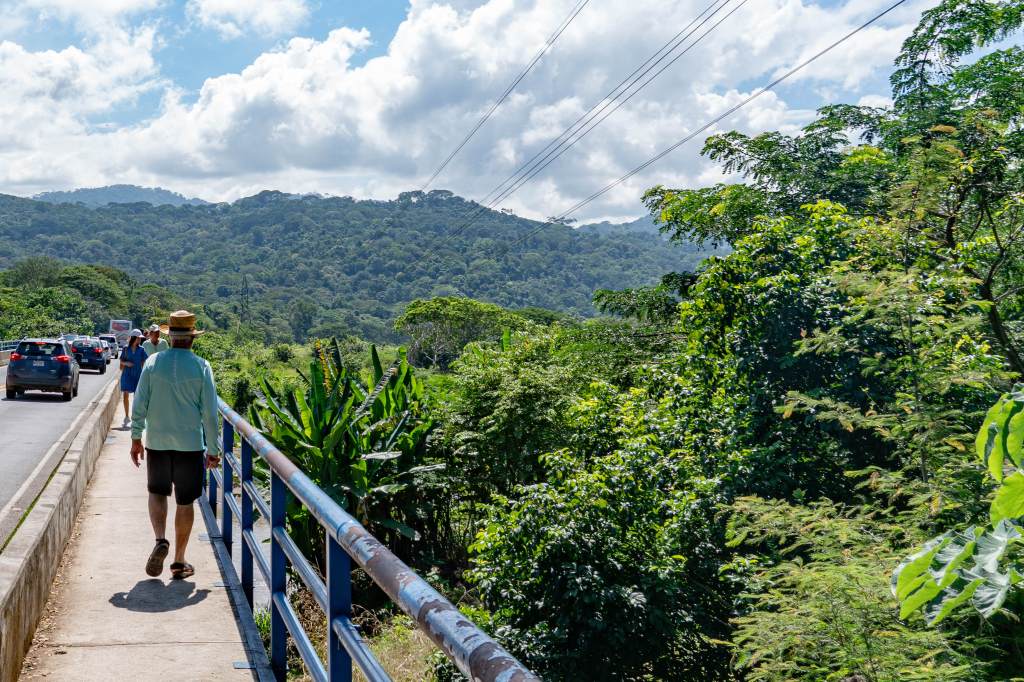
About 30 minutes before we arrived in Jaco beach, we stopped at the famous Crocodile Bridge over the Rio Tarcoles. While you used to have to brave a narrow piece of concrete with traffic buzzing by, we were able to walk along the somewhat new and wide sidewalk over the bridge. At times, you can see dozens of American crocodiles, that can get up to around 13 feet long. We saw one monster of a crocodile that locals called ‘Mike Tyson’ due to his record setting 15 foot length. We only viewed him from the bridge, but here’s a video of a boat tour where the guides got up close with the croc.
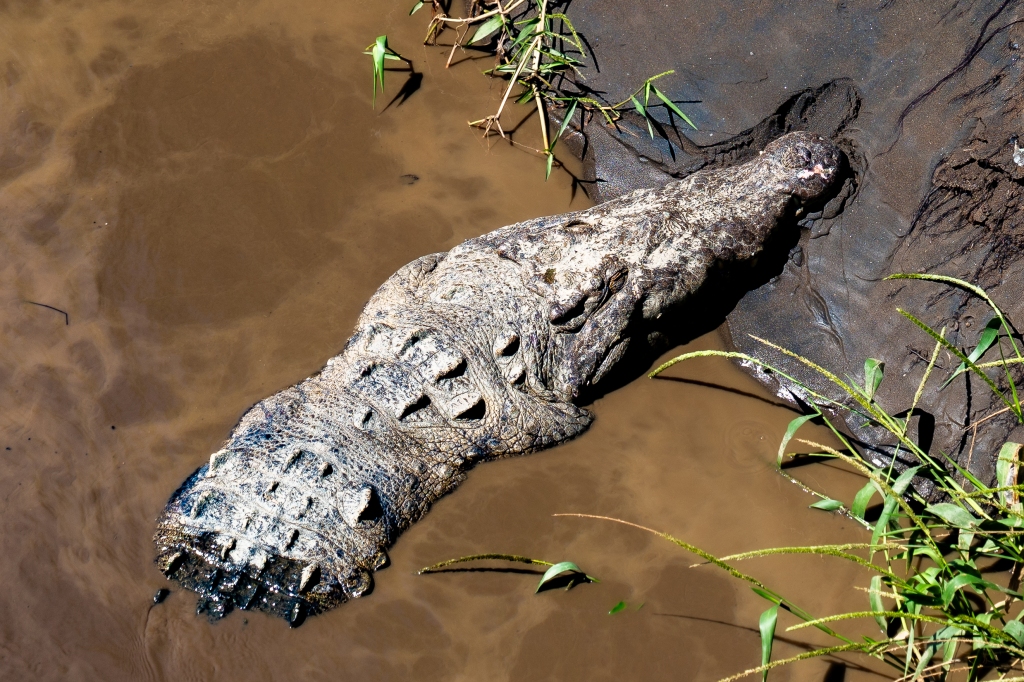
We got ourselves checked in to our balcony room overlooking the pool at the nicely appointed and decently priced (around $150/night) Hotel Jaco. The hotel had a pool, bar, restaurant, gym (never saw it), a spa (didn’t use), and quick access to the beach. They also had surfboard rentals for $25/day, which I quickly took advantage of in the approachable surf of Jaco beach. The last time I surfed was in Hawaii in 2017, but I was able to get up on the board again after a few tries. I was able to get an hour lesson from some instructors on the beach for $40, and they were incredibly helpful in the short amount of time. The next day, I was able to catch a lot more waves, and ride them longer, on my own thanks to the lesson. Jaco beach is also a jumping off point for world renowned deep-sea fishing of marlin, bluefin, tuna, wahoo and more. This was a bucket list item for my dad, and while I suggested it giving a go, he said he wanted my mother to be his +1 for the day of his trophy catch.
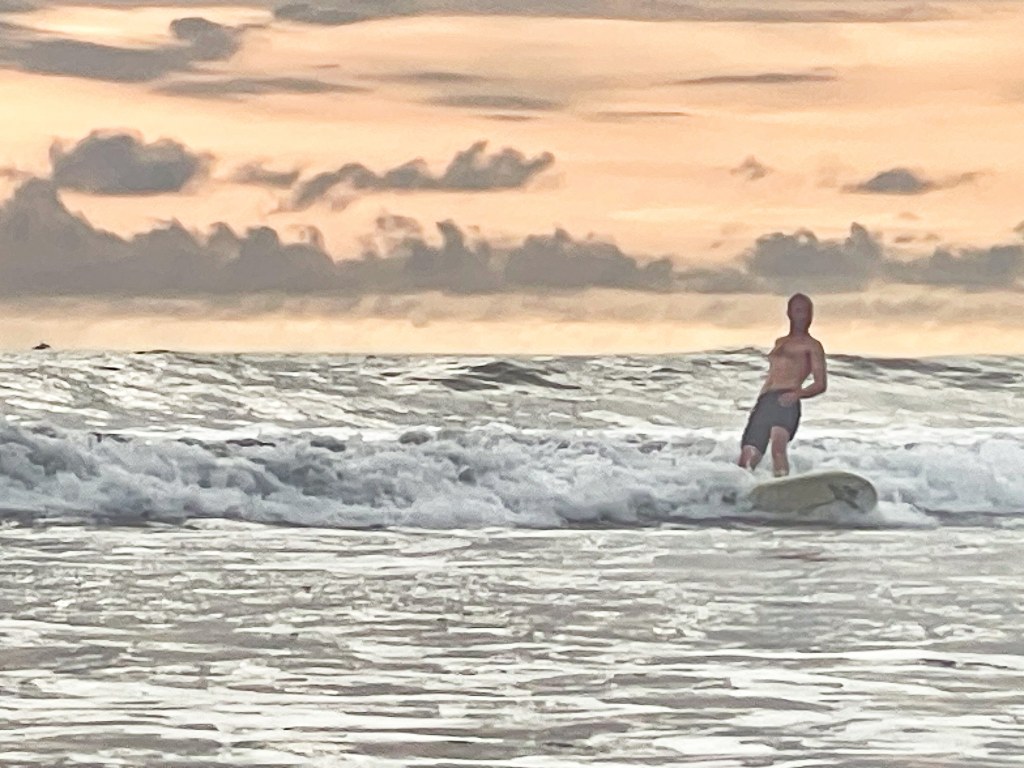
Day 6
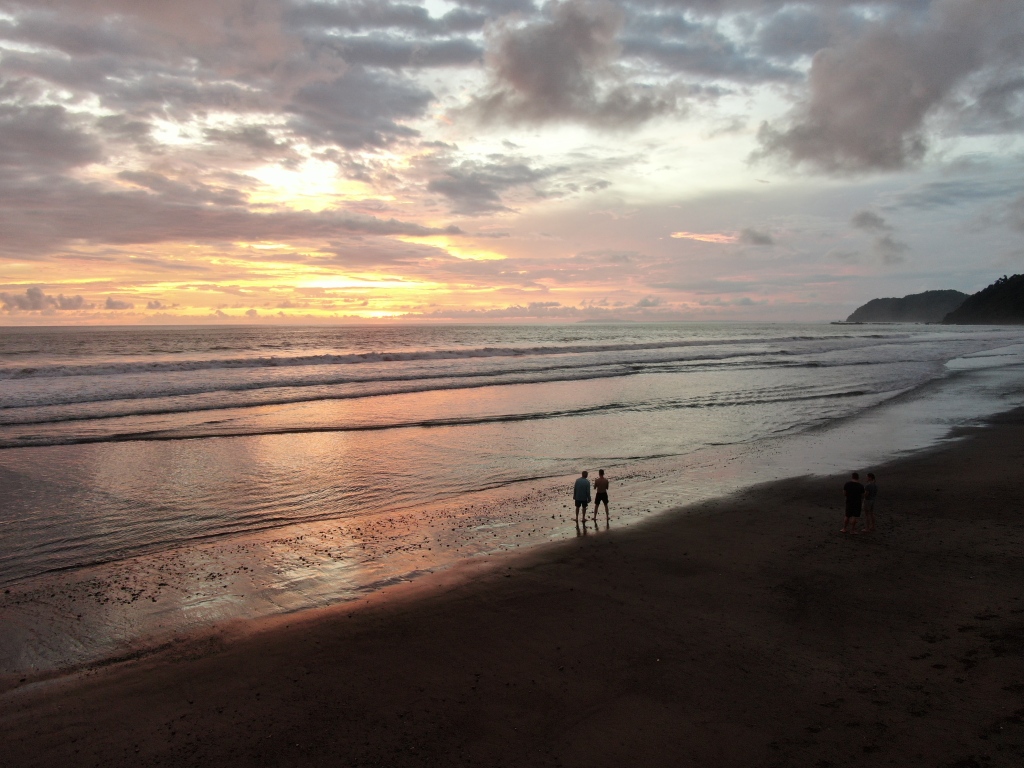
After all of the adventures of the past week, my dad and I took a day to relax on the beach, surf a bit, enjoy the $15 buckets of beer by the pool, and enjoy a few cigars with the sunset. We ate at a local soda in the morning, had pizza for a late lunch/dinner (surprisingly good), and turned in for the night.
Day 7
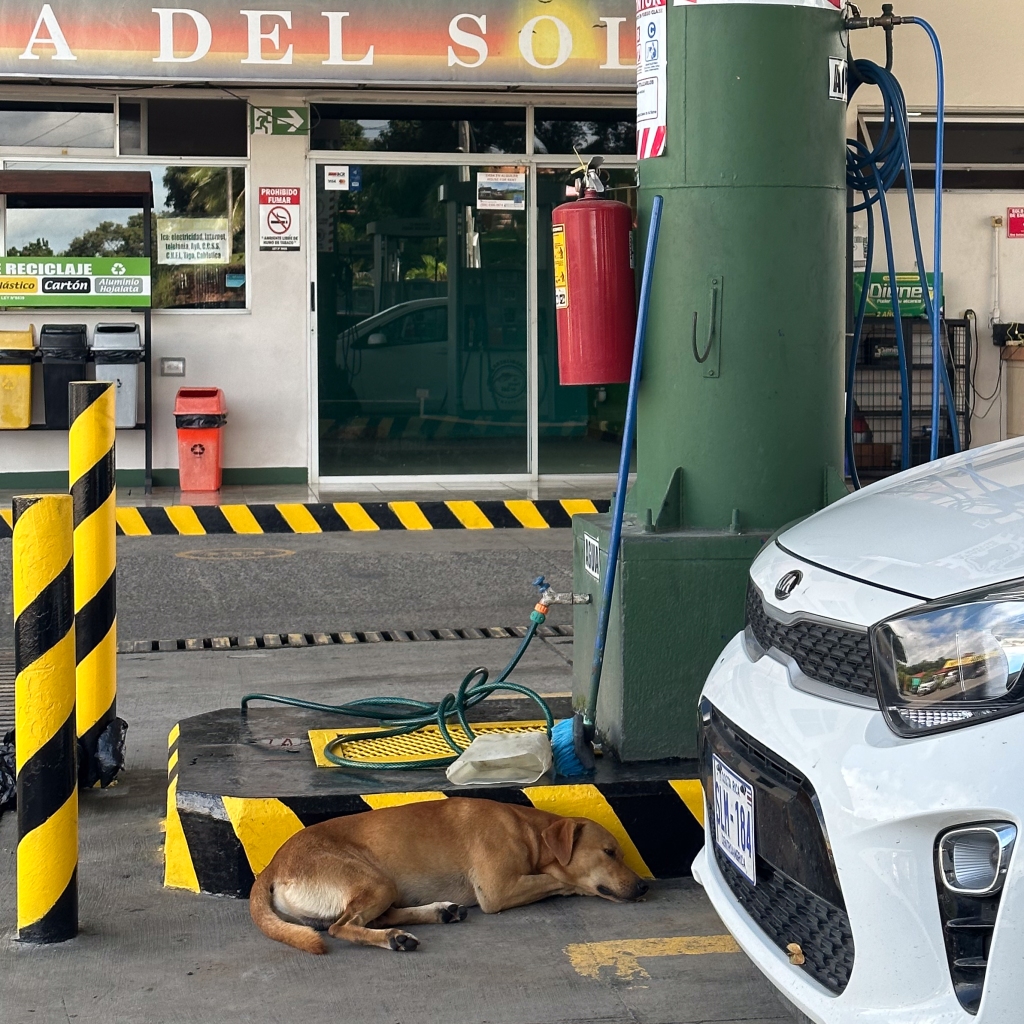
This day was essentially a travel day, as I had to drop my dad back off at the San Jose airport, and then wait for my friend Courtney’s flight to arrive an hour or so later. Once she arrived, we headed back towards Jaco beach to start the next portion of the trip. Originally, we had planned to head straight from Jaco to Dominical, but once we had learned just how long some drives can be (as well as the trickiness after dark), we were happy that Hotel Jaco was able to extend our stay a night. This was actually one of the few nights that we ventured out much after dark as we walked from the hotel to the main strip for something to eat. The Jaco strip is a little touristy, so stick to the sodas if you prefer more local and budget food, as some of the restaurants have definitely applied the tourist tax.
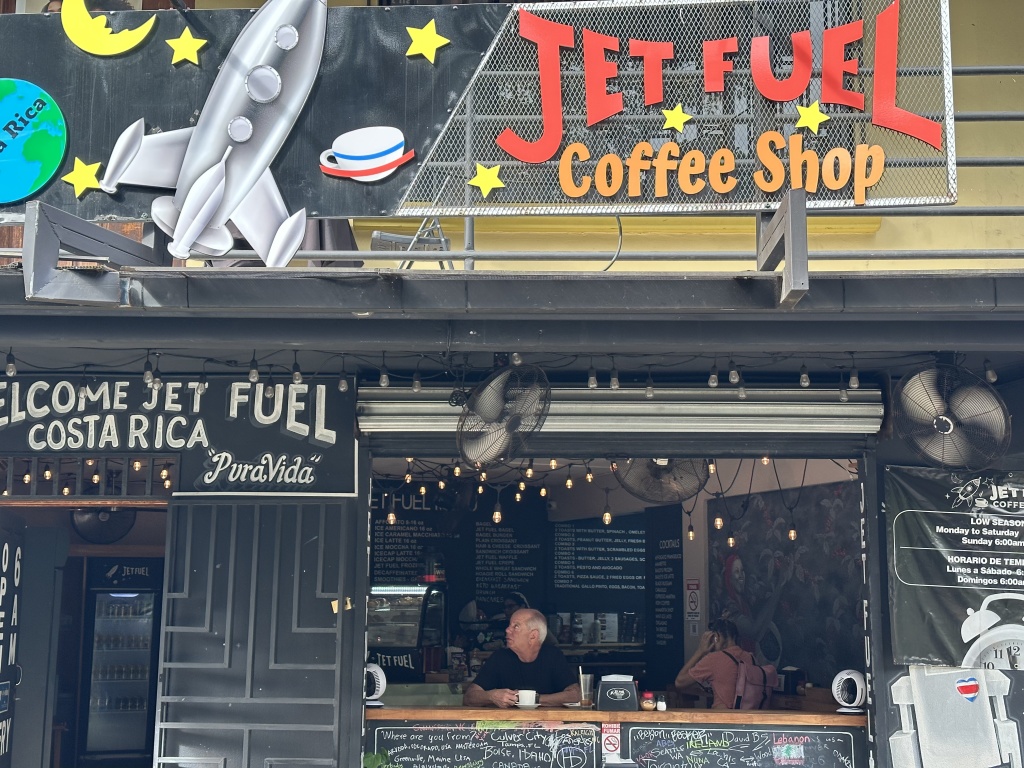
Day 8
We woke up and took advantage of the beautiful weather on the beach (as well as the 11am checkout time) with some last minute surfing and a beach run for Courtney (who was training for a marathon). She’d end up running a half marathon 2 days before our 26.5 mile hike of Cerro Chirripo later this week. After our time on the beach, we got checked out of the hotel and made the short drive south to the El Miro Ruins – a short but steep 1.5 mile hike up to the remnants of an old mansion looking over the coast. While the history of the mansion is a little uncertain, it’s thought that a wealthy individual began construction but died before the project could be completed.
. The hike itself was free, but we did have to pay the parking attendant roughly $3. The short and mostly paved trek up to the ruins was a quick workout, and the views from the hotel’s old walkways were a unique photography opportunity. Graffiti covered most of the interior walls of the ruins, but the bulk of it was done artistically. There were even some life like portraits here and there, which we found beautiful in their own right, but everyone feels different about graffiti.
Dominical
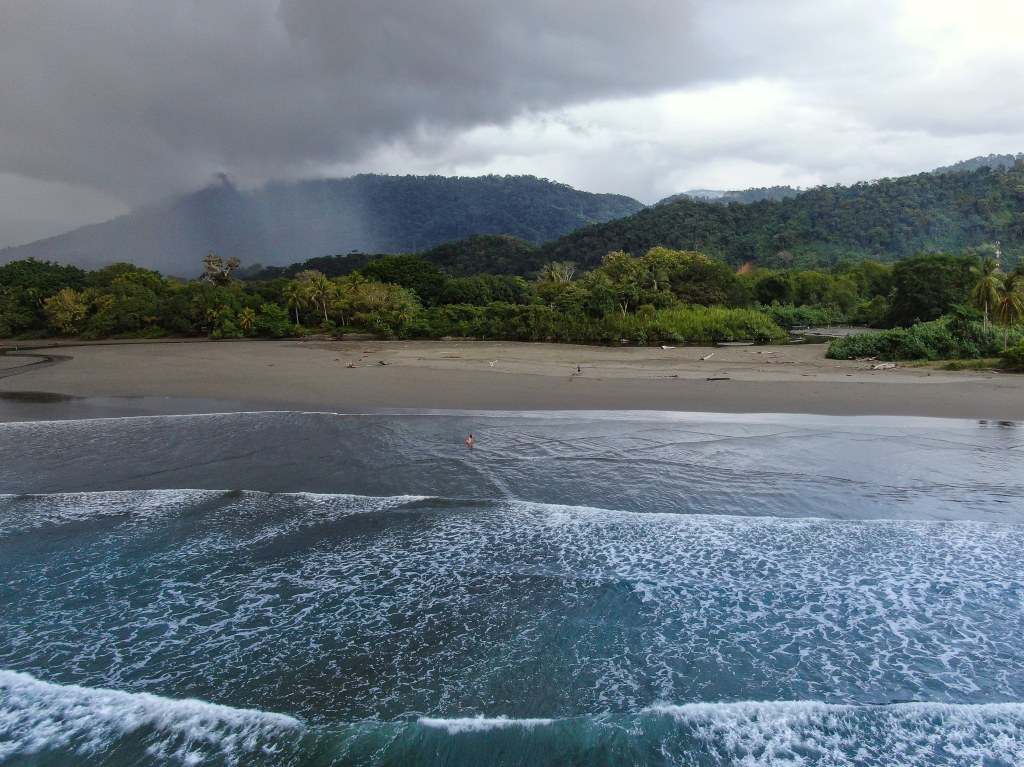
Day 8
We drove from Jaco to a small little beach town just north of Dominical, Savegre de Aguirre, and its beautiful Matapalo beach. Our AirBnB was less than a quarter of mile to the beach. This AirBnB also had a gate around it, and our host did warn us about bringing valuables to the beach, and not to venture out too long after dark. We did exercise some additional caution in this area, but overall still felt safe overall. Our host also pointed out that the beach was notorious for its rip currents, so we didn’t go out farther than about waist deep while we were there. The beach and its sunsets were near perfect though, and we had it to ourselves most of the time we spent there. The first night,, we caught a sunset and got some sleep before the next day of waterfall chasing.
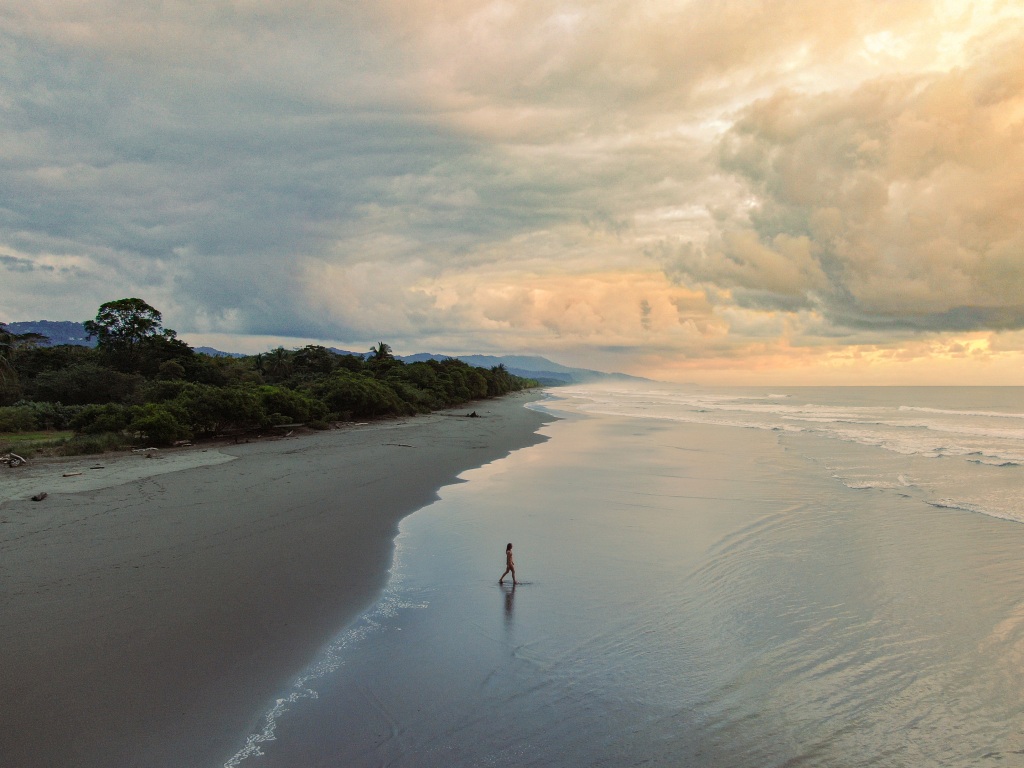
Day 9
We made our reservations online for the Nauyaca Falls trail, a roughly 5 mile hike to a double waterfall in a canyon through the rainforest. It was about a 40 minute drive from Savegre de Aguirre to the Nauyaca Falls trailhead, with the last section consisting of a beautiful winded forest road. The hike can be quite hot, but you can opt to pay extra for a 4×4 road that will take you almost all of the way up to the falls.
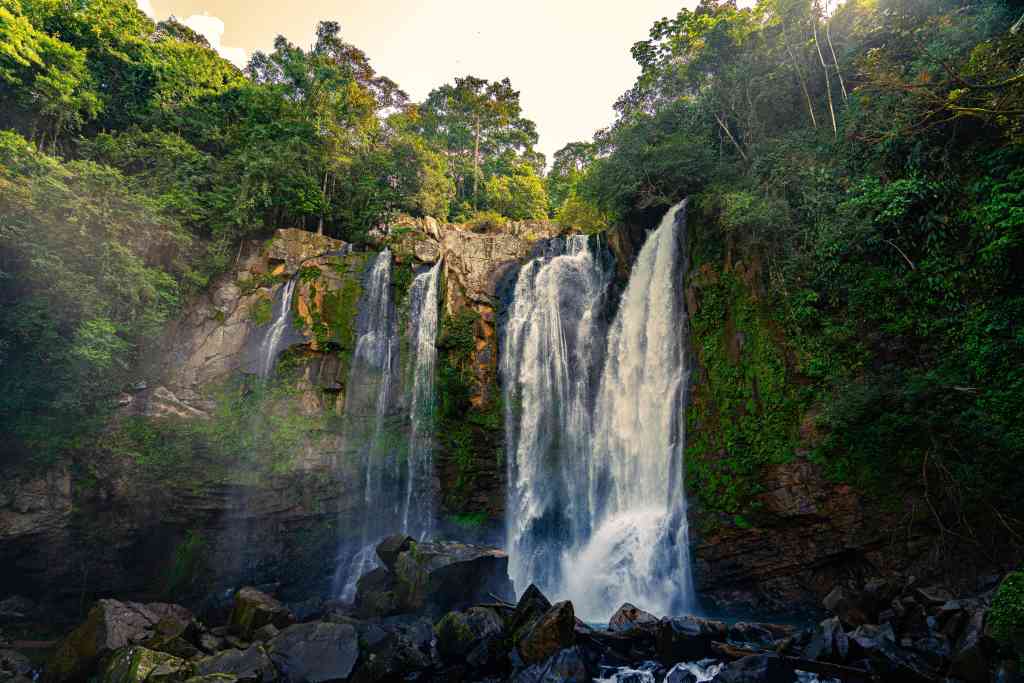
The cost of entry is $10 if you are just hiking, or $32 if you opt for the 4×4 ride. We obviously did the hike option. We really enjoyed the photo opportunities and solitude of the upper falls, and then went down for a swim in the more social atmosphere of the lower falls’ plunge pools. As mid day crept upon us, the crowds did too, and we dipped out of there before it got slammed.
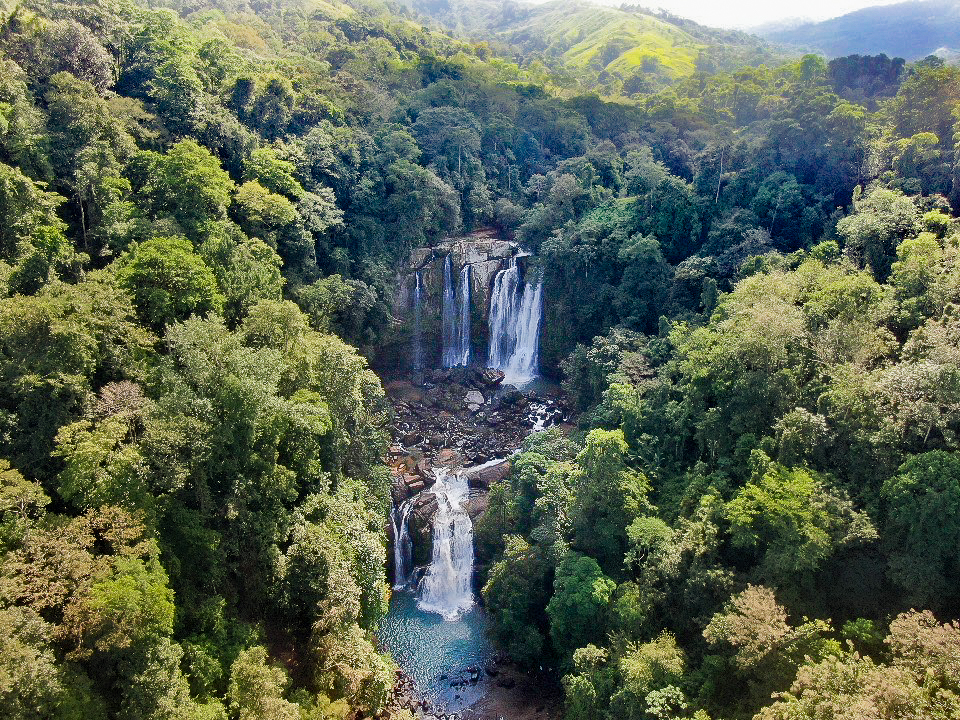
We were in the mood to continue chasing waterfalls, and had seen signs for another waterfall in the area, Eco Chontales, and decided to head there. This decision would nearly get us stuck in the jungle later that day, but we’ll get there in a bit. Our drive in was on an unpaved road with a little bit of mud and some loose stone, but overall an easy drive as far as off roading goes.
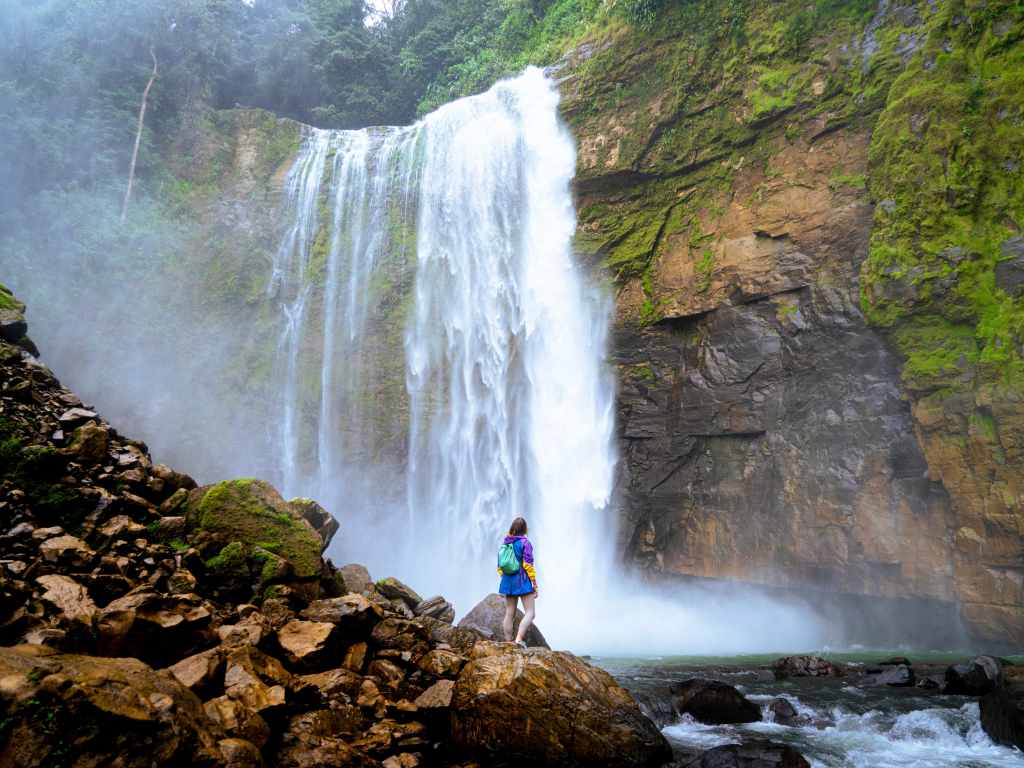
The waterfall is another one that is on private land, and so you’ll need to pay the $10 per person entry at the office before doing the hike. Let the office know if you’d like to eat at the family restaurant at the bottom of the falls – we didn’t do this, but reviews seem to say good things. It was another short but steep hike down through the rainforest to the falls, which had a viewing platform for photos as well as stone steps down to the water level.
When we attempted to drive back to our AirBnB, for some reason our GPS decided to route us through a 4×4 only route – and backwards. What this meant is that the 4×4 only warning signs were not visible to us as we began driving, and once we realized what we had gotten ourselves into, we were past the point of no return. The muddy, rutted, broken and steep ‘road’ was quickly getting worse, and we had descended a slope that the car would not have been able to make it back up. We pressed on, at this point accepting that the car might be damaged, but that any damage to the car would still be cheaper than attempting to call for a tow/recovery. We slipped, slid, scraped and bounced are way through incredibly sketchy terrain, with Courtney often getting out of the car to help guide over and around obstacles. I was grateful for the capability of that little Mitsubishi.
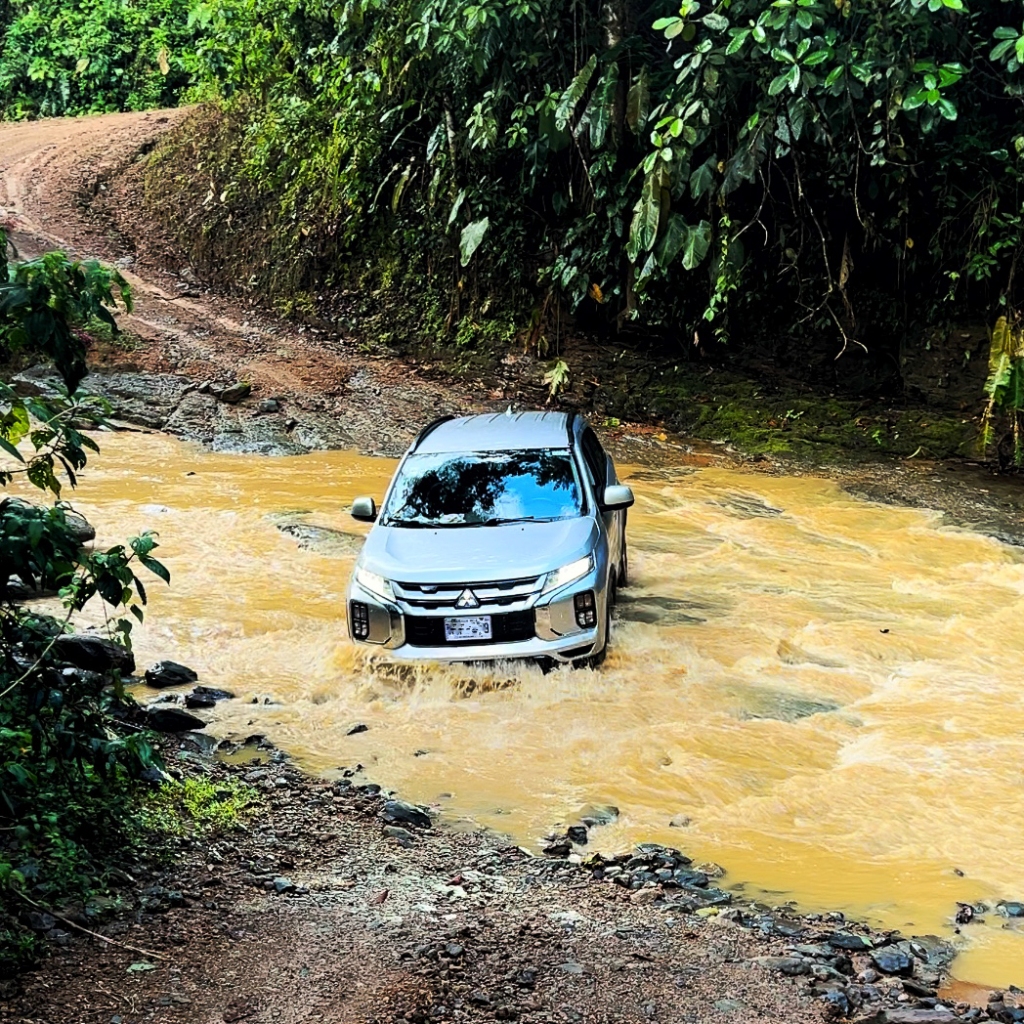
The first deep water crossing (pictured) was nerve-wracking, as this car did not have much clearance and the water was moving quickly. We made it though, until a short while later we came upon another crossing that was rockier, deeper, and full of obstacles such as fallen logs and random debris. At this point, I was truly unsure if the car would make it through. We had a little over a quarter tank of fuel left, no cell service, and a sun that was getting lower in the sky.
We went out to scope the terrain – my best guess said that just after this water crossing, we would be able to get back on to a regular road. If this was the case, it would be worth it to just ‘send it’ through and hope for the best. However, if it was another long stretch of 4×4 road or another deep crossing ahead, we were considering camping for the night and trying to turn around the next morning. We saw a house as we went out to scope the road, and called out for anyone home, but it was either vacant or abandoned. To my relief, about a quarter mile past this crossing, there was indeed a connection to a real road. With adrenaline pumping we ran back to the car, moved what debris we could, and SENT IT. We were so rattled at that point that we didn’t bother with a video, but Courtney noted that at one point the water was over the hood of the car. We made it out, got on the more paved but still unpaved road, got directions from a local we saw on our way out, and then went back to our airbnb exhausted, but relieved. What a day.
Day 10
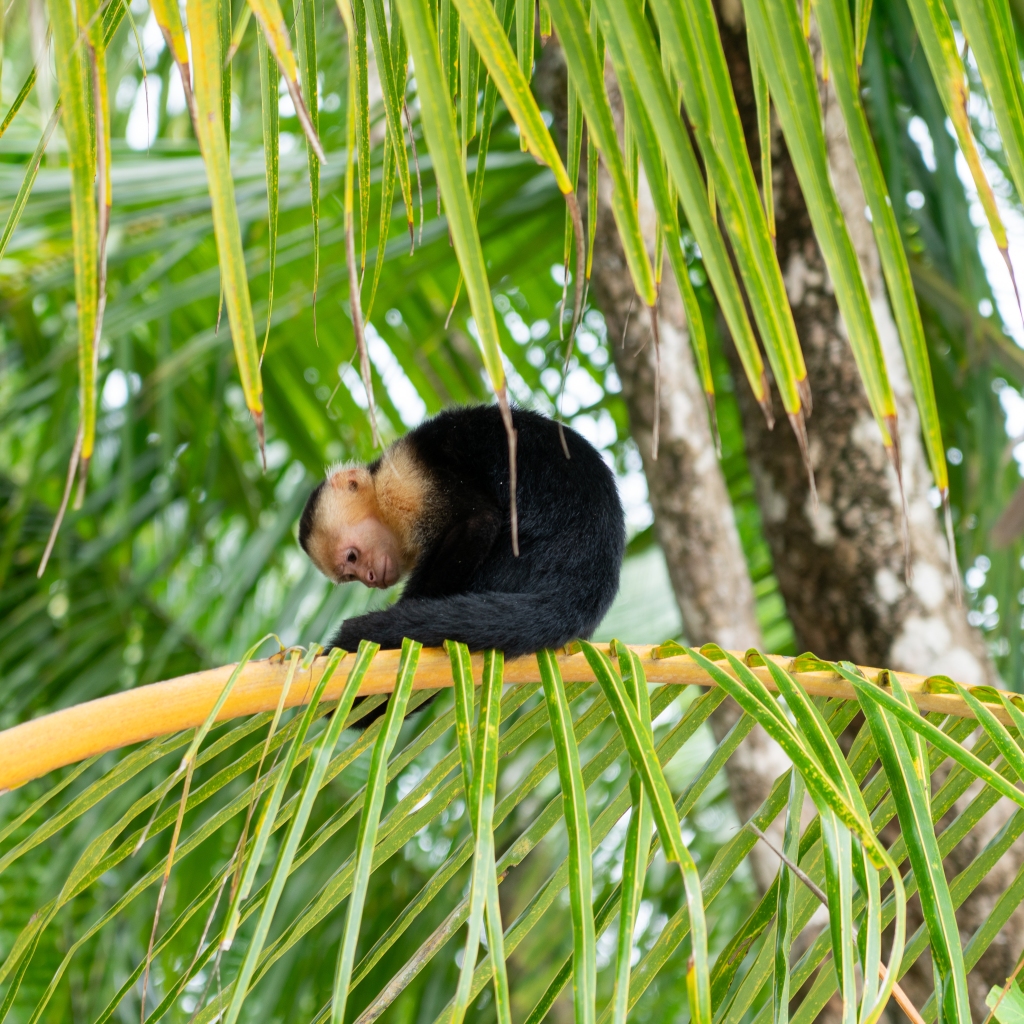
Manuel Antonio National Park, renowned for its beaches and wildlife (particularly, the monkeys) was on our agenda for today. Once again, you will have to go to the Costa Rica government website to get your reservation for the park. They are broken down by time windows – and can fill up QUICKLY. We were lucky to be able to get our passes just a few days in advance, but it’s wise to try to reserve your time slots ahead of time. When you arrive in the town of Quepos, you’ll quickly see the tourist economy around the park – loaded with street vendors, touristy food, resort style beaches, and parking attendants galore. There are parking attendants who will try to usher you into their private beach parking ($20+ to park), even though there are spots you can park closer to the entrance for much cheaper. We were duped by these high pressure tactics, so if you want to save some money and get a closer parking spot, don’t let these attendants push you into the beach parking lots. As you walk towards the park, high pressure vendors and tour guides will be trying to sell your their wares – and one guide got angry with us when we respectfully declined his services.
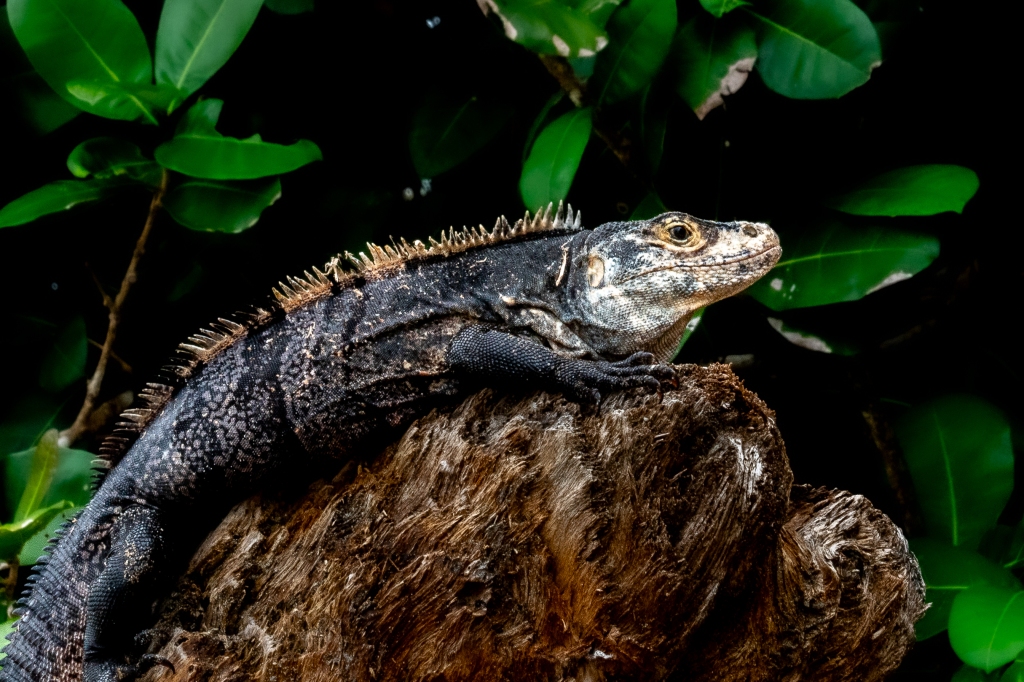
Once we got parked and checked in, the vibe calmed down as we transitioned back into nature. The boardwalk trail takes you through the marsh areas and out to the pristine beaches. Along the way, we spotted sloths in the trees, as well as brightly colored crabs on the forest floor. Once out on the beaches, we were treated to a troop of monkey and a large iguana posing for us.
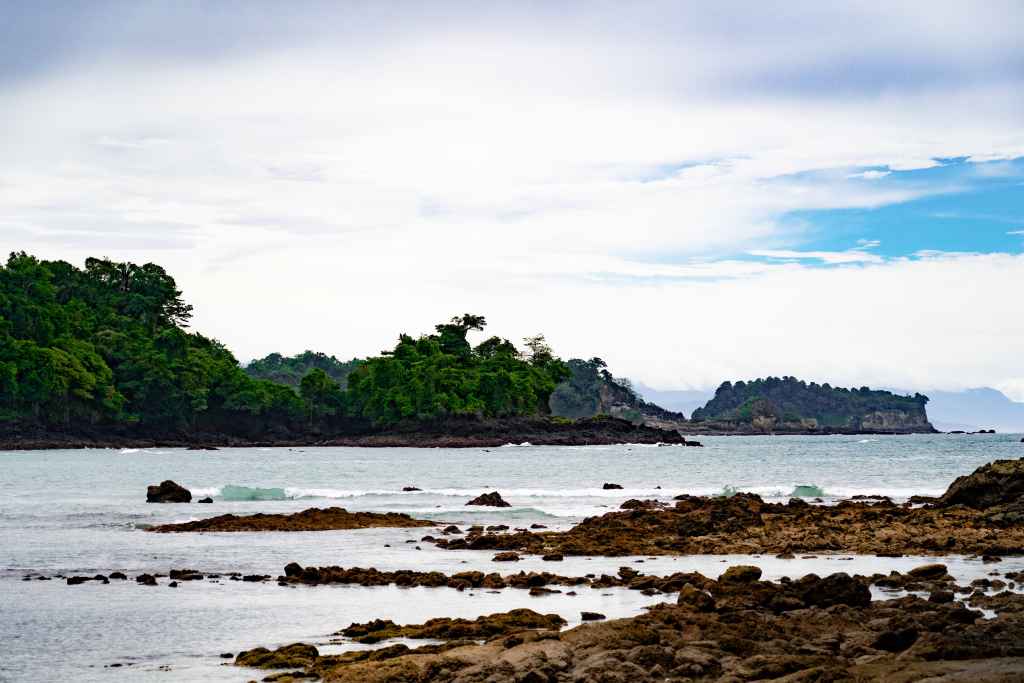
The rocky coast, white sand, calm waters, dense forest just off of the beach and wildlife were great to experience in Manuel Antonio. You’ve got a few different nature trails and beaches to choose from within the park, but after hanging on the beach for a while, we decided if we were going to chill on a beach for a day, we might as well do it at the one right next to our AirBnB. When you’re researching Manuel Antonio, you may see some articles touting it as one of the ‘most beautiful national parks in the world’ – and while I agree it was beautiful and unique, I wouldn’t put it that close to the top.
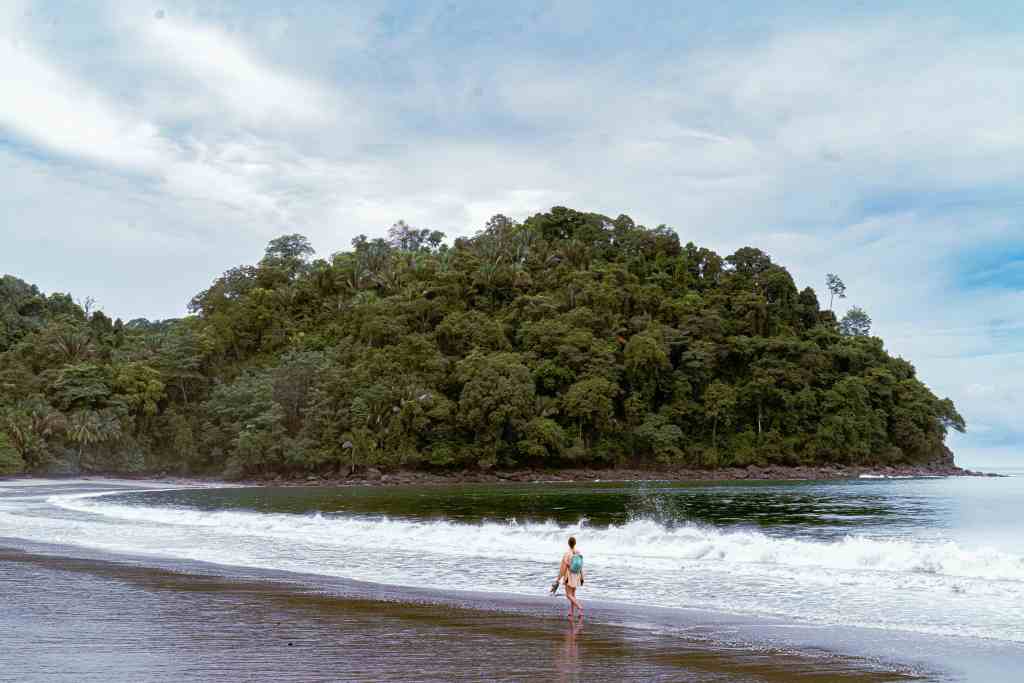
Day 11
We stopped by the Marina Bellena National Park in Uvita. This park, which translates to ‘whale marina’ is named for its large, whale-tail shaped sandbar that connects the beach to a small island at low tide.
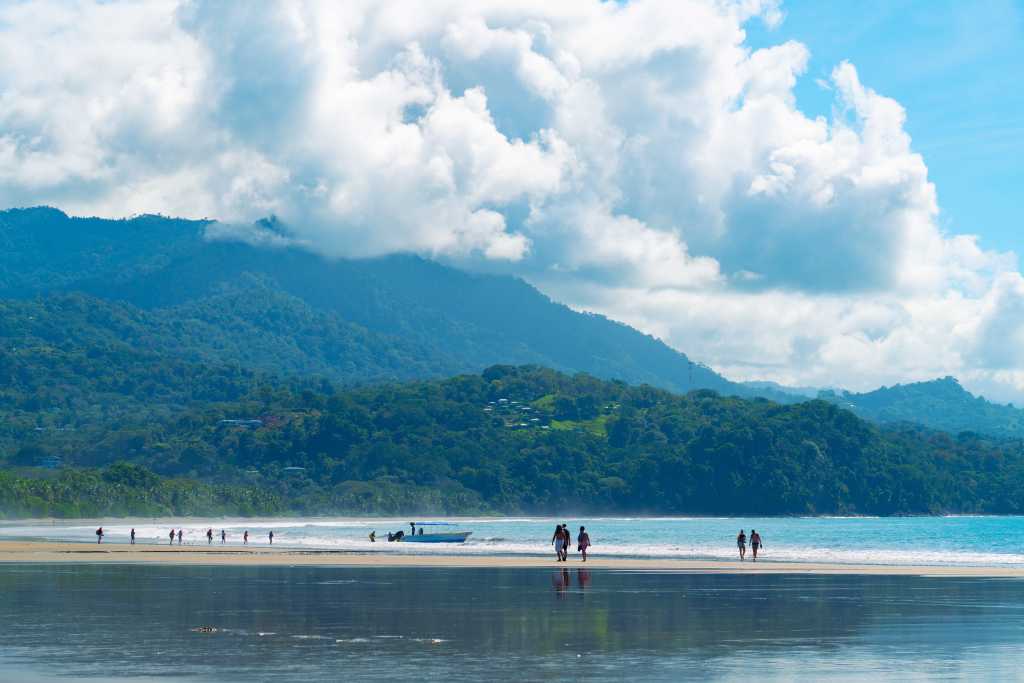
The tide was low when we visited, and so we were able to walk all the way out on the sand causeway. The waters on either side were calm and protected, perfect for sitting in chest high water and letting the gentle waves wash over you. Had I not lost my drone earlier in the trip, I would have loved to get a shot of the sandbar from the air where its shape is clearly seen. From ground level, you just feel like you’re on another beautiful beach.
Rivas – the Gateway to Cerro Chirripo
Day 11
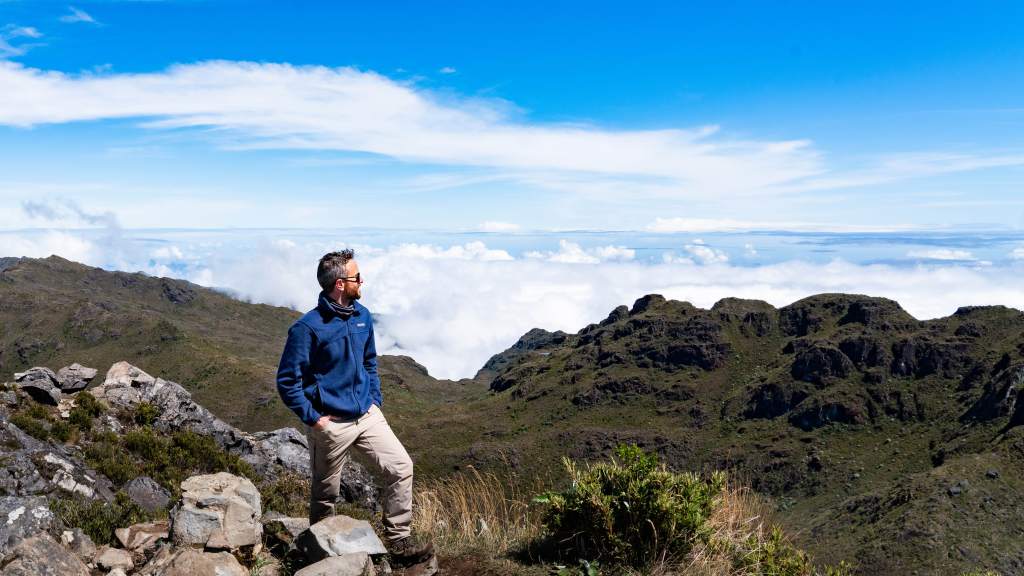
We said goodbye to the beaches, and began the drive to our eco-lodge in Rivas, a small town nestled just below 3,000 feet high in the mountainous region of the Perez Zeledon province. The eco-lodge would be our basecamp for our attempt on Cerro Chirripo – the 12,535 ft peak that towers over the rest of Costa Rica. It was the perfect spot – $150 total for four nights in a private room with a private bathroom. There was a large balcony and main living area, a well-stocked communal kitchen, and the cherry on top – a private spot along the river below. And, it was just over a half mile drive up to the Cerro Chirripo trailhead.
We went to the park permit office to get our permits for the next morning. Most people who attempt the 26 mile, out and back hike up Cerro Chirripo will opt to stay a night or two at the Crestones Basecamp lodge, which is about 9 miles into the hike. The rustic lodge features bunk beds, hot water, wifi and a small restaurant that breaks the hike up into 2-3 days. Because we decided on this hike so late, we were unable to get spots in the lodge, and so would be doing the hike in one straight shot. When we shared this plan with the park ranger, we received a hearty laugh in return, as the ranger seemed to think it was a bit much for us. Turns out, it was a bit much, but we did it!
Day 12
Our day began at midnight, with a flat tire on the rental car of all things. We quickly got it changed and then proceeded up to the trailhead. We had negotiated a parking spot the night before for just $6 for the entire day. The trail begins winding through the rainforest with a steady incline as you begin working up the 7,500 ft elevation gain of the trail. By daybreak, we were out of the forest and into the higher altitude terrain as we made it to the Crestones basecamp just before 9 am. After a cup of coffee, we set out from there for the remaining 3.5 miles up to the summit, which we made a little after 11am.
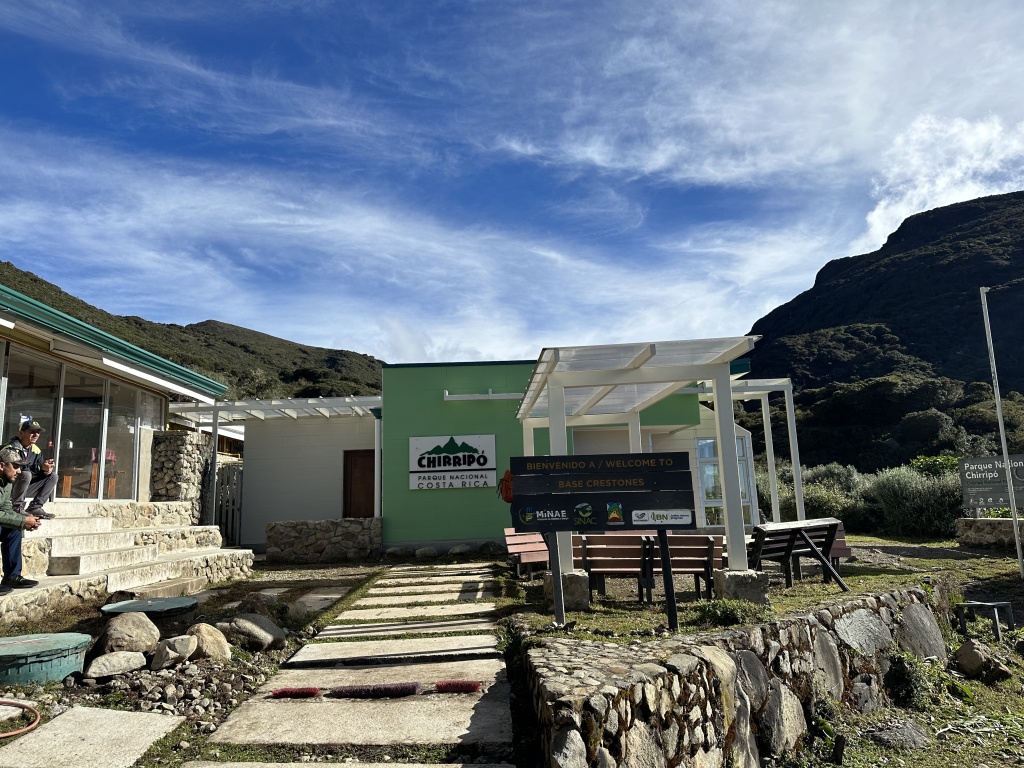
The last mile up to the summit is rocky with some high knee steps and places where you’ll need to use your hands, but there luckily wasn’t too much exposure. The hardest park of this hike, hands down, was just the overall distance and then the relentless downhill on the way out. We took some time to celebrate on the summit before working our way down – a grueling, knee torturing and bug ridden venture back the way we came.
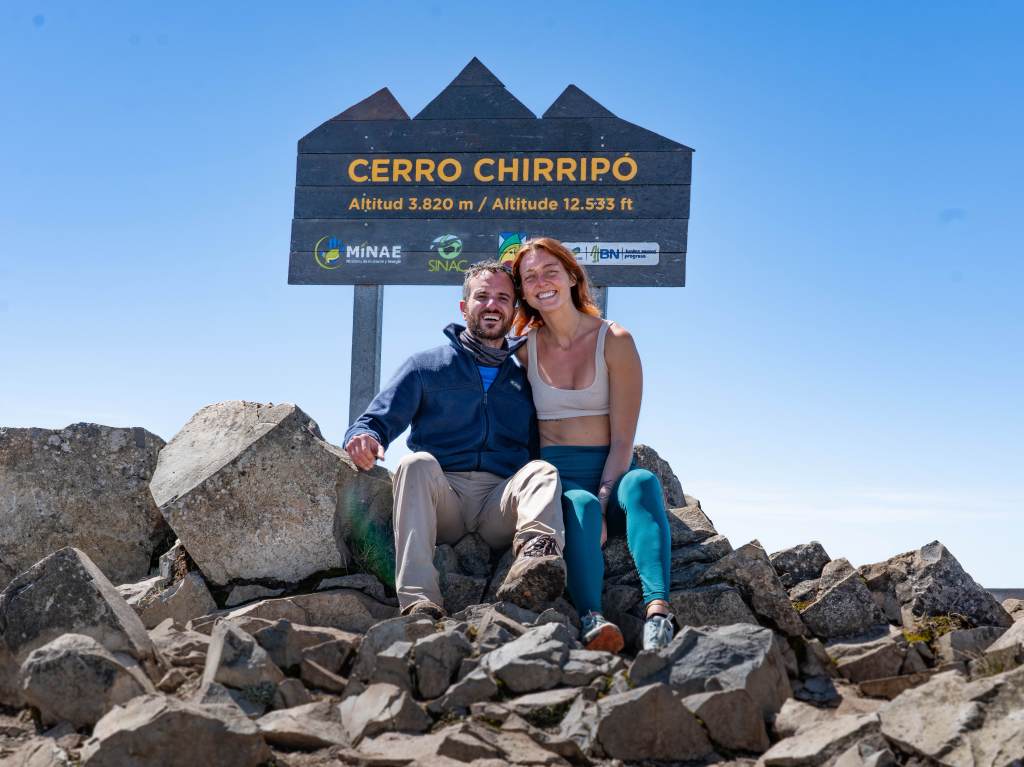
When we arrived back to the car a little after 6 pm, we were BEAT but proud of the accomplishment. The hike was the largest combination of mileage and elevation gain that I had ever done in one shot.
Day 13
After the wild day before, just getting ourselves down the steps to the river beneath the lodge was a challenge enough. We spent the day relaxing there, eating endlessly, and basking in the warm sunshine from the back porch. We went to a local restaurant, Kapi Kapi (for the third time that trip), and it happened to be karaoke night there. We did not partake, but it was fun to watch some of the locals.
Day 14
We got ourselves packed up and began the 4-ish hour drive over the continental divide highway back to San Jose. We both had early flights out the next morning, and so had grabbed a $50 airbnb a few minutes away from the airport. We were in an urban area, and it was cool to hear the sounds of the city after having been in the rainforest and coast for so many nights. We grabbed some food and called it a night. It was a great two weeks in Costa Rica!
